 | –≠–ª–µ–∫—Ç—Ä–æ–Ω–Ω—ã–π –∫–æ–º–ø–æ–Ω–µ–Ω—Ç: RTL8169SB | –°–∫–∞—á–∞—Ç—å:  PDF PDF  ZIP ZIP |

INTEGRATED GIGABIT ETHERNET CONTROLLER (NIC)
DATASHEET
Rev. 1.5
10 August 2004
Track ID: JATR-1076-21
RTL8169SB(L)

RTL8169SB(L)
Datasheet
Integrated Gigabit Ethernet Controller (NIC) ii Track ID: JATR-1076-21 Rev. 1.5
COPYRIGHT
©2004 Realtek Semiconductor Corp. All rights reserved. No part of this document may be reproduced,
transmitted, transcribed, stored in a retrieval system, or translated into any language in any form or by any
means without the written permission of Realtek Semiconductor Corp.
TRADEMARKS
Realtek is a trademark of Realtek Semiconductor Corporation. Other names mentioned in this document
are trademarks/registered trademarks of their respective owners.
DISCLAIMER
Realtek provides this document "as is", without warranty of any kind, neither expressed nor implied,
including, but not limited to, the particular purpose. Realtek may make improvements and/or changes in
this document or in the product described in this document at any time. This document could include
technical inaccuracies or typographical errors.
USING THIS DOCUMENT
This document is intended for use by the software engineer when programming for Realtek
RTL8169SB(L) controller chips. Information pertaining to the hardware design of products using these
chips is contained in a separate document.
Though every effort has been made to ensure that this document is current and accurate, more information
may have become available subsequent to the production of this guide. In that event, please contact your
Realtek representative for additional information that may help in the development process.
REVISION HISTORY
Revision
Release Date
Summary
1.0 2003/11/17
First
release.
1.1
2004/01/28
EEDI/AUX and EEDO description changed in Table 3, page 7.
Pin 11 changed from NC to VSS (see Table 8, page 9).
Pin 12 changed from NC to AVDDH (see Table 8, page 9).
1.2
2004/04/16
Add CardBus, Boot ROM function related content (see Table 1, page 4).
1.3 2004/07/09
Revised VDD25 parameters (see Table 12, page 26, and Table 15, page 27).
Corrected `VDD25' pin name to `AVDDL'.
1.4
2004/07/26
Revised AVDDL parameters (see Table 12, page 26, and Table 15, page 27).
1.5 2004/08/10
Revised Pin 126 (VDD12A) description (see Table 8, page 9, Table 11, page 26,
Table 12, page 26, and Table 15, page 27).

RTL8169SB(L)
Datasheet
Integrated Gigabit Ethernet Controller (NIC) iii Track ID: JATR-1076-21 Rev. 1.5
Table of Contents
1.
GENERAL DESCRIPTION................................................................................................................................................1
2.
FEATURES...........................................................................................................................................................................2
3.
SYSTEM APPLICATIONS.................................................................................................................................................2
4.
PIN ASSIGNMENTS ...........................................................................................................................................................3
5.
PIN DESCRIPTIONS ..........................................................................................................................................................4
5.1.
P
OWER
M
ANAGEMENT
/I
SOLATION
...............................................................................................................................4
5.2.
PCI I
NTERFACE
............................................................................................................................................................5
5.3.
EEPROM ....................................................................................................................................................................7
5.4.
T
RANSCEIVER
I
NTERFACE
............................................................................................................................................7
5.5.
C
LOCK
.........................................................................................................................................................................8
5.6.
R
EGULATOR
& R
EFERENCE
..........................................................................................................................................8
5.7.
LED
S
...........................................................................................................................................................................8
5.8.
P
OWER
& G
ROUND
......................................................................................................................................................9
5.9.
NC (N
OT
C
ONNECTED
) P
INS
........................................................................................................................................9
6.
FUNCTIONAL DESCRIPTION.......................................................................................................................................10
6.1.
PCI B
US
I
NTERFACE
..................................................................................................................................................10
6.1.1.
Byte Ordering .......................................................................................................................................................10
6.1.2.
Interrupt Control .................................................................................................................................................. 11
6.1.3.
Latency Timer ....................................................................................................................................................... 11
6.1.4.
64-Bit Addressing ................................................................................................................................................. 11
6.2.
PCI B
US
O
PERATION
..................................................................................................................................................12
6.2.1.
Target Read...........................................................................................................................................................12
6.2.2.
Target Write ..........................................................................................................................................................13
6.2.3.
Master Read .........................................................................................................................................................14
6.2.4.
Master Write .........................................................................................................................................................15
6.2.5.
Configuration Access............................................................................................................................................16

RTL8169SB(L)
Datasheet
Integrated Gigabit Ethernet Controller (NIC) iv Track ID: JATR-1076-21 Rev. 1.5
6.3.
LED F
UNCTIONS
........................................................................................................................................................17
6.3.1.
Link Monitor.........................................................................................................................................................17
6.3.2.
Rx LED .................................................................................................................................................................17
6.3.3.
Tx LED .................................................................................................................................................................18
6.3.4.
Tx/Rx LED ............................................................................................................................................................19
6.3.5.
LINK/ACT LED ....................................................................................................................................................20
6.4.
PHY T
RANSCEIVER
....................................................................................................................................................21
6.4.1.
PHY Transmitter ...................................................................................................................................................21
6.4.2.
PHY Receiver........................................................................................................................................................21
6.5.
N
EXT
P
AGE
................................................................................................................................................................22
6.6.
EEPROM I
NTERFACE
................................................................................................................................................22
6.7.
P
OWER
M
ANAGEMENT
...............................................................................................................................................23
7.
CHARACTERISTICS .......................................................................................................................................................26
7.1.
A
BSOLUTE
M
AXIMUM
R
ATINGS
.................................................................................................................................26
7.2.
R
ECOMMENDED
O
PERATING
C
ONDITIONS
.................................................................................................................26
7.3.
C
RYSTAL
R
EQUIREMENTS
..........................................................................................................................................26
7.4.
T
HERMAL
C
HARACTERISTICS
.....................................................................................................................................27
7.5.
DC C
HARACTERISTICS
...............................................................................................................................................27
7.6.
AC C
HARACTERISTICS
...............................................................................................................................................28
7.6.1.
Serial EEPROM Interface Timing ........................................................................................................................28
7.7.
PCI B
US
O
PERATION
T
IMING
.....................................................................................................................................29
7.7.1.
PCI Bus Timing Parameters .................................................................................................................................29
7.7.2.
PCI Clock Specification .......................................................................................................................................31
7.7.3.
PCI Transactions ..................................................................................................................................................32
8.
MECHANICAL DIMENSIONS .......................................................................................................................................39
8.1.
128-P
IN
QFP M
ECHANICAL
D
IMENSIONS
..................................................................................................................39
8.2.
N
OTES FOR
128-P
IN
QFP D
IMENSIONS
......................................................................................................................40
8.3.
128-P
IN
LQFP M
ECHANICAL
D
IMENSIONS
................................................................................................................41
8.4.
N
OTES FOR
128-P
IN
LQFP D
IMENSIONS
....................................................................................................................42
9.
ORDERING INFORMATION..........................................................................................................................................43

RTL8169SB(L)
Datasheet
Integrated Gigabit Ethernet Controller (NIC) v Track ID: JATR-1076-21 Rev. 1.5
List of Tables
T
ABLE
1. P
OWER
M
ANAGEMENT
/I
SOLATION
..............................................................................................................................4
T
ABLE
2. PCI I
NTERFACE
...........................................................................................................................................................5
T
ABLE
3. EEPROM ....................................................................................................................................................................7
T
ABLE
4. T
RANSCEIVER
I
NTERFACE
............................................................................................................................................7
T
ABLE
5. C
LOCK
.........................................................................................................................................................................8
T
ABLE
6. R
EGULATOR
& R
EFERENCE
.........................................................................................................................................8
T
ABLE
7. LED
S
...........................................................................................................................................................................8
T
ABLE
8. P
OWER
& G
ROUND
......................................................................................................................................................9
T
ABLE
9. NC (N
OT
C
ONNECTED
) P
INS
.......................................................................................................................................9
T
ABLE
10. EEPROM I
NTERFACE
...............................................................................................................................................22
T
ABLE
11. A
BSOLUTE
M
AXIMUM
R
ATINGS
................................................................................................................................26
T
ABLE
12. R
ECOMMENDED
O
PERATING
C
ONDITIONS
.................................................................................................................26
T
ABLE
13. C
RYSTAL
R
EQUIREMENTS
.........................................................................................................................................26
T
ABLE
14. T
HERMAL
C
HARACTERISTICS
....................................................................................................................................27
T
ABLE
15. DC C
HARACTERISTICS
..............................................................................................................................................27
T
ABLE
16. EEPROM A
CCESS
T
IMING
P
ARAMETERS
.................................................................................................................28
T
ABLE
17. PCI B
US
T
IMING
P
ARAMETERS
.................................................................................................................................29
T
ABLE
18. M
EASUREMENT
C
ONDITION
P
ARAMETERS
................................................................................................................30
T
ABLE
19. C
LOCK AND
R
ESET
S
PECIFICATIONS
..........................................................................................................................31
T
ABLE
20. O
RDERING
I
NFORMATION
..........................................................................................................................................43

RTL8169SB(L)
Datasheet
Integrated Gigabit Ethernet Controller (NIC) vi Track ID: JATR-1076-21 Rev. 1.5
List of Figures
F
IGURE
1. RTL8169SB(L) 128-P
IN
(L)QFP P
IN
A
SSIGNMENTS
.................................................................................................3
F
IGURE
2. L
ITTLE
-E
NDIAN
B
YTE
O
RDERING
.............................................................................................................................10
F
IGURE
3. B
IG
-E
NDIAN
B
YTE
O
RDERING
..................................................................................................................................11
F
IGURE
4. T
ARGET
R
EAD
O
PERATION
.......................................................................................................................................12
F
IGURE
5. T
ARGET
W
RITE
O
PERATION
.....................................................................................................................................13
F
IGURE
6. M
ASTER
R
EAD
O
PERATION
......................................................................................................................................14
F
IGURE
7. M
ASTER
W
RITE
O
PERATION
.....................................................................................................................................15
F
IGURE
8. R
X
LED....................................................................................................................................................................17
F
IGURE
9. T
X
LED....................................................................................................................................................................18
F
IGURE
10. T
X
/R
X
LED..............................................................................................................................................................19
F
IGURE
11. LINK/ACT LED......................................................................................................................................................20
F
IGURE
12. S
ERIAL
EEPROM I
NTERFACE
T
IMING
.....................................................................................................................28
F
IGURE
13. O
UTPUT
T
IMING
M
EASUREMENT
C
ONDITIONS
.........................................................................................................30
F
IGURE
14. I
NPUT
T
IMING
M
EASUREMENT
C
ONDITIONS
............................................................................................................30
F
IGURE
15. 3.3V C
LOCK
W
AVEFORM
.........................................................................................................................................31
F
IGURE
16. C
LOCK
S
KEW
D
IAGRAM
...........................................................................................................................................31
F
IGURE
17. I/O R
EAD
.................................................................................................................................................................32
F
IGURE
18. I/O W
RITE
................................................................................................................................................................32
F
IGURE
19. C
ONFIGURATION
R
EAD
............................................................................................................................................33
F
IGURE
20. C
ONFIGURATION
W
RITE
...........................................................................................................................................33
F
IGURE
21. B
US
A
RBITRATION
...................................................................................................................................................34
F
IGURE
22. M
EMORY
R
EAD
B
ELOW
4GB...................................................................................................................................34
F
IGURE
23. M
EMORY
W
RITE
B
ELOW
4GB .................................................................................................................................35
F
IGURE
24. T
ARGET
I
NITIATED
T
ERMINATION
- D
ISCONNECT
....................................................................................................35
F
IGURE
25. T
ARGET
I
NITIATED
T
ERMINATION
- A
BORT
.............................................................................................................36
F
IGURE
26. M
ASTER
I
NITIATED
T
ERMINATION
- A
BORT
.............................................................................................................36
F
IGURE
27. P
ARITY
O
PERATION
≠ O
NE
E
XAMPLE
......................................................................................................................37
F
IGURE
28. M
EMORY
R
EAD
A
BOVE
4GB (DAC) .......................................................................................................................38
F
IGURE
29. M
EMORY
W
RITE
A
BOVE
4GB (DAC)......................................................................................................................38

RTL8169SB(L)
Datasheet
Integrated Gigabit Ethernet Controller (NIC) 1
Track ID: JATR-1076-21 Rev. 1.5
1. General
Description
The Realtek RTL8169SB(L) NIC Gigabit Ethernet controllers (RTL8169SB (128-QFP) &
RTL8169SBL (128-LQFP)) combine a triple-speed IEEE 802.3 compliant Media Access Controller
(MAC) with a triple-speed Ethernet transceiver, 32-bit PCI bus controller, and embedded memory. With
state-of-the-art DSP technology and mixed-mode signal technology, they offer high-speed transmission
over CAT 5 UTP cable or CAT 3 UTP (10Mbps only) cable. Functions such as Crossover Detection &
Auto-Correction, polarity correction, adaptive equalization, cross-talk cancellation, echo cancellation,
timing recovery, and error correction are implemented to provide robust transmission and reception
capability at high speeds.
The devices support the PCI v2.3 and CardBus (RTL8169SBL only) bus interfaces for host
communications with power management, and comply with the IEEE 802.3 specification for 10/100Mbps
Ethernet and the IEEE 802.3ab specification for 1000Mbps Ethernet. They also support an auxiliary power
auto-detect function, and will auto-configure related bits of the PCI power management registers in PCI
configuration space.
They support the Advanced Configuration Power management Interface (ACPI)--power management for
modern operating systems that are capable of Operating System-directed Power Management (OSPM)--to
achieve the most efficient power management possible. PCI Message Signaled Interrupt (MSI) is also
supported.
In addition to the ACPI feature, the RTL8169SB(L) supports remote wake-up (including AMD Magic
Packet, Re-LinkOk, and Microsoft
Æ
Wake-up frame) in both ACPI and APM (Advanced Power
Management) environments. The LWAKE pin provides four different output signals including active high,
active low, positive pulse, and negative pulse. The versatility of the LWAKE pin provides motherboards
with Wake-On-LAN (WOL) functionality. To support WOL from a deep power down state (e.g. D3cold,
i.e. main power is off and only auxiliary exists), the auxiliary power source must be able to provide the
needed power for the RTL8169SB(L).
The RTL8169SB(L) is fully compliant with Microsoft
Æ
NDIS5 (IP, TCP, UDP) Checksum and
Segmentation Task-offload features, and supports IEEE 802 IP Layer 2 priority encoding and 802.1Q
Virtual bridged Local Area Network (VLAN). The above features contribute to lowering CPU utilization,
especially benefiting performance when in operation on a network server. Also, the devices boost their PCI
performance by supporting PCI Memory Read Line & Memory Read Multiple when transmitting, and
Memory Write and Invalidate when receiving. To better qualify for server use, the RTL8169SB(L) support
the PCI Dual Address Cycle (DAC) command when the assigned buffers reside at a physical memory
address higher than 4 Gigabytes.

RTL8169SB(L)
Datasheet
Integrated Gigabit Ethernet Controller (NIC) 2
Track ID: JATR-1076-21 Rev. 1.5
2. Features
Integrated 10/100/1000 transceiver
Auto-Negotiation with Next Page
capability
Supports PCI rev.2.3, 32-bit,
33/66MHz
The RTL8169SBL supports CardBus
mode. The CIS data can be stored in
either EEPROM or expansion ROM
Supports pair swap/polarity/skew
correction
Crossover Detection &
Auto-Correction
Wake-on-LAN and remote wake-up
support
Microsoft
Æ
NDIS5 Checksum Offload
(IP, TCP, UDP) and largesend offload
support
Supports Full Duplex flow control
(IEEE 802.3x)
Fully compliant with IEEE 802.3,
IEEE 802.3u, IEEE 802.3ab
Supports IEEE 802.1P Layer 2 Priority
Encoding
Supports IEEE 802.1Q VLAN tagging
Serial EEPROM
Supports up to 128Kbytes Boot ROM
3.3V signaling, 5V PCI I/O tolerant
Transmit/Receive FIFO (8K/64K)
support
Supports power down/link down power
saving
Supports PCI Message Signaled
Interrupt (MSI)
128-pin QFP package (RTL8169SB)
and 128-pin LQFP package
(RTL8169SBL)
3. System
Applications
Gigabit Ethernet Network Interface Card
Gigabit Ethernet CardBus Card
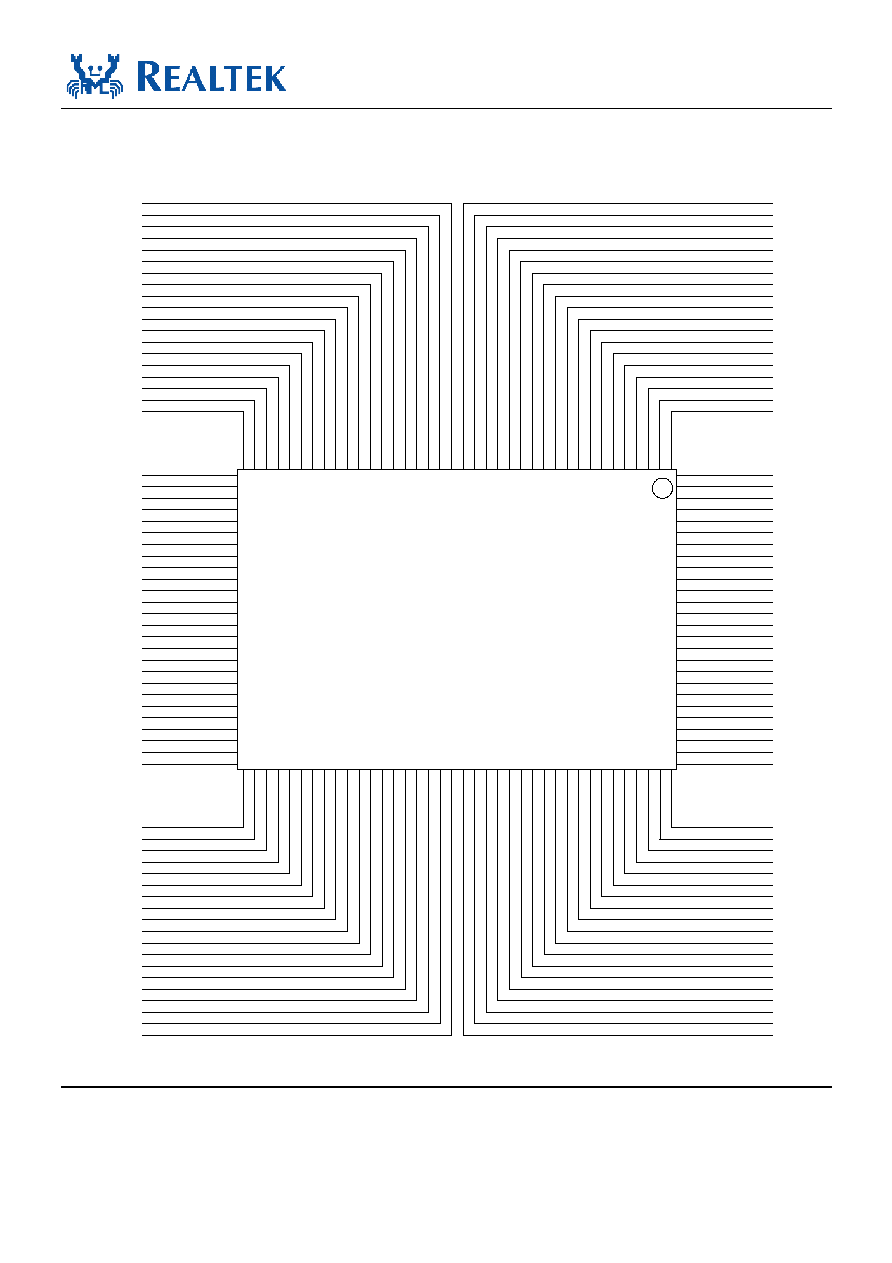
RTL8169SB(L)
Datasheet
Integrated Gigabit Ethernet Controller (NIC) 3
Track ID: JATR-1076-21 Rev. 1.5
4. Pin
Assignments
1
MDI0+
2
MDI0-
3
AVDDL
4
VSS
5
MDI1+
6
MDI1-
7
AVDDL
8
CTRL25
9
VSS
11
AVDDH
12
10
13
14
VSS
15
MDI2+
16
MDI2-
17
AVDDL
18
VSS
19
MDI3+
MDI3-
38
VSSPST
37
PCIAD28
36
PCIAD29
34
GND
33
PCIAD30
32
35
PCIAD31
31
VDD12
30
PMEB
REQB
29
GNTB
28
PCICLK
27
PCIRSTB
26
VDD33
25
INTAB
23
VDD12
21
ISOLATEB
22
24
GND
VSSPST
20
AVDDL
39
PCIAD27
40
PCIAD26
41
VDD33
42
PCIAD25
43
PCIAD24
44
CBEB3
45
VDD12
46
IDSEL
47
PCIAD23
48
GND
49
PCIAD22
50
PCIAD21
51
VSSPST
52
GND
53
PCIAD20
54
VDD12
55
PCIAD19
56
VDD33
57
PCIAD18
58
PCIAD17
59
PCIAD16
CBEB2
61
FRAMEB
62
GND
63
IRDYB
64
VDD12
65 CLKRUNB on
SBL Version.
NC on SB Ver.
66
VSSPST
67
TRDYB
68
DEVSELB
69
STOPB
70
PERRB
71
VDD33
72
NC
73
GND
74
NC
75
SERRB
76
PAR
77
CBEB1
78
VDD12
79
PCIAD15
80
GND
81
VSSPST
82
PCIAD14
83
PCIAD13
128
VSS
127
RSET
126
VDD12A
125
CTRL12
124
VSS
123
VSS
122
XTAL2
121
XTAL1
120
AVDDH
119
VSSPST
118
GND
117
LED0
116
VDD12
115
LED1
114
LED2
113
LED3
112
GND
111
EESK
110
VDD12
109
EEDI
108
EEDO
107
VDD33
106
EECS
105
LANWAKE/CSTSCHG
104
PCIAD0
103
PCIAD1
102
PCIAD2
101
VSSPST
100
GND
99
VDD12
98
PCIAD3
97
PCIAD4
96
PCIAD5
95
PCIAD6
94
VDD33
93
PCIAD7
92
CBEB0
91
VSSPST
90
PCIAD8
89
PCIAD9
88
M66EN
87
PCIAD10
86
PCIAD11
85
PCIAD12
84
VDD33
RTL8169SB(L)
AVDDH
VSS
60
Figure 1. RTL8169SB(L) 128-Pin (L)QFP Pin Assignments

RTL8169SB(L)
Datasheet
Integrated Gigabit Ethernet Controller (NIC) 4
Track ID: JATR-1076-21 Rev. 1.5
5. Pin
Descriptions
The following signal type codes are used in the tables:
I: Input.
O: Output.
T/S: Tri-State bi-directional input/output pin.
S/T/S: Sustained Tri-State.
O/D: Open Drain.
5.1. Power
Management/Isolation
Table 1. Power Management/Isolation
Symbol
Type
Pin No
Description
PMEB
(PME#)
O/D
31
Power Management Event: Open drain, active low.
Used to request a change in the current power management state and/or to indicate
that a power management event has occurred.
ISOLATEB
(ISOLATE#)
I
23
Isolate Pin: Active low.
Used to isolate the RTL8169SB(L) from the PCI bus. The RTL8169SB(L) will not
drive its PCI outputs (excluding PME#) and will not sample its PCI input (including
PCIRSTB and PCICLK) as long as the Isolate pin is asserted.
LANWAKE/
CSTSCHG
O
105
LAN WAKE-UP Signal (When CardB_En=0, bit2 Config3):
This signal is used to inform the motherboard to execute the wake-up process. The
motherboard must support Wake-On-LAN (WOL). There are 4 choices of output
that may be asserted from the LANWAKE pin (active high, active low, positive
pulse, and negative pulse). We can configure the LANWAKE output via two
CONFIG bits: LWACT(Config1.4) and LWPTN(Config4.2).
LWACT
LWAKE Output
0
1
0 Active
high
Active
low
LWPTN
1 Positive
pulse Negative
pulse
The default output is an active high signal. Once a PME event is received, the
LANWAKE and PMEB assert at the same time when the LWPME (bit4,
CONFIG4) is set to 0. If the LWPME is set to 1, the LANWAKE asserts only when
PMEB asserts and ISOLATEB is low.
CSTSCHG Signal (When CardB_En=1, bit2 Config3):
This signal is used by the RTL8169SBL in CardBus applications only and is used to
inform the motherboard to execute the wake-up process whenever a PME event
occurs. This is always an active high signal, and the setting of LWACT (bit 4,
Config1), LWPTN (bit2, Config4), and LWPME (bit4, Config4) is irrelevant in this
case.

RTL8169SB(L)
Datasheet
Integrated Gigabit Ethernet Controller (NIC) 5
Track ID: JATR-1076-21 Rev. 1.5
5.2. PCI
Interface
Table 2. PCI Interface
Symbol
Type
Pin No
Description
PCIADPIN31-0 T/S
33, 34, 36,
37, 39, 40,
42, 43, 47,
49, 50, 53,
55, 57, 58,
59, 79, 82,
83, 85, 86,
87, 89, 90,
93, 95, 96,
97, 98, 102,
103, 104
AD31-0: Low 32-bit PCI address and data multiplexed pins. The address
phase is the first clock cycle in which FRAMEB is asserted. During the
address phase, AD31-0 contains a physical address (32 bits). For I/O, this is
a byte address, and for configuration and memory, it is a double-word
address. The RTL8169SB(L) supports both big-endian and little-endian byte
ordering. Write data is stable and valid when IRDYB is asserted. Read data
is stable and valid when TRDYB is asserted. Data I is transferred during
those clocks where both IRDYB and TRDYB are asserted.
PCIADPIN31-24 are shared with Boot ROM data pins, while
PCIADPIN16-0 are shared with Boot ROM address pins.
CBEBPIN7-4 T/S PCI bus command and Byte Enables multiplex pins. During the address
phase of a transaction, CBEBPIN7-4 defines the bus command. During the
data phase, CBEBPIN7-4 are used as Byte Enables. The Byte Enables are
valid for the entire data phase and determine which byte lanes carry
meaningful data. CBEBPIN4 applies to byte 4, and CBEBPIN7 applies to
byte 7.
CBEBPIN3-0
T/S 44, 60, 77, 92 PCI bus command and Byte Enables multiplex pins. During the address
phase of a transaction, CBEBPIN3-0 defines the bus command. During the
data phase, CBEBPIN3-0 are used as Byte Enables. The Byte Enables are
valid for the entire data phase and determine which byte lanes carry
meaningful data. CBEBPIN0 applies to byte 0, and CBEBPIN3 applies to
byte 3.
PCICLK I
28
PCI clock: This clock input provides timing for all PCI transactions and is
input to the PCI device. Supports up to a 66MHz PCI clock.
CLKRUNB
on the
RTL8169SBL
NC on the
RTL8169SB
I/O
65
Clock Run: On the RTL8169SB this pin is Not Connected.
This signal is used by the RTL8169SBL to request starting (or speeding up)
of the PCICLK clock. CLKRUNB also indicates the clock status. For the
RTL8169SBL, CLKRUNB is an open drain output as well as an input. The
RTL8169SBL requests the central resource to start, speed up, or maintain the
interface clock by the assertion of CLKRUNB. For the host system, it is an
S/T/S signal. The host system (central resource) is responsible for
maintaining CLKRUNB asserted, and for driving it high to the negated
(deasserted) state.
DEVSELB S/T/S
68
Device Select: As a bus master, the RTL8169SB(L) samples this signal to
insure that a PCI target recognizes the destination address for the data
transfer. As a target, the RTL8169SB(L) asserts this signal low when it
recognizes its target address after FRAMEB is asserted.
FRAMEB S/T/S
61
Cycle Frame: As a bus master, this pin indicates the beginning and duration
of an access. FRAMEB is asserted low to indicate the start of a bus
transaction. While FRAMEB is asserted, data transfer continues. When
FRAMEB is de-asserted, the transaction is in the final data phase.
As a target, the device monitors this signal before decoding the address to
check if the current transaction is addressed to it.

RTL8169SB(L)
Datasheet
Integrated Gigabit Ethernet Controller (NIC) 6
Track ID: JATR-1076-21 Rev. 1.5
Symbol
Type
Pin No
Description
GNTB I
29
Grant: This signal is asserted low to indicate to the RTL8169SB(L) that the
central arbiter has granted the ownership of the bus to the RTL8169SB(L).
This input is used when the device is acting as a bus master.
REQB T/S
30
Request: The RTL8169SB(L) will assert this signal low to request the
ownership of the bus from the central arbiter.
IDSEL I
46
Initialization Device Select: This pin allows the device to identify when
configuration read/write transactions are intended for it.
INTAB O/D
25
Interrupt A: Used to request an interrupt. It is asserted low when an interrupt
condition occurs, as defined by the Interrupt Status, Interrupt Mask.
IRDYB S/T/S
63
Initiator Ready: This indicates the initiating agent's ability to complete the
current data phase of the transaction.
As a bus master, this signal will be asserted low when the device is ready to
complete the current data phase transaction. This signal is used in
conjunction with the TRDYB signal. Data transaction takes place at the
rising edge of CLK when both IRDYB and TRDYB are asserted low. As a
target, this signal indicates that the master has put data on the bus.
TRDYB S/T/S
67
Target Ready: This indicates the target agent's ability to complete the current
phase of the transaction.
As a bus master, this signal indicates that the target is ready for the data
during write operations, or is ready to provide the data during read
operations.
As a target, this signal will be asserted low when the (slave) device is ready
to complete the current data phase transaction. This signal is used in
conjunction with the IRDYB signal. Data transaction takes place at the rising
edge of CLK, when both IRDYB and TRDYB are asserted low.
PAR T/S
76
Parity: This signal indicates even parity across PCIADPIN31-0 and
CBEB3-0 including the PAR pin. PAR is stable and valid one clock after
each address phase. For data phase, PAR is stable and valid one clock after
either IRDYB is asserted on a write transaction or TRDYB is asserted on a
read transaction. Once PAR is valid, it remains valid until one clock after the
completion of the current data phase. As a bus master, PAR is asserted
during address and write data phases. As a target, PAR is asserted during
read data phases.
M66EN I
88
66MHZ_ENABLE: This pin indicates to the device whether the bus segment
is operating at 66 or 33MHz. When this pin (active high) is asserted, the
current PCI bus segment that the device resides on operates in 66MHz mode.
If this pin is de-asserted, the current PCI bus segment operates in 33MHz
mode.
PERRB S/T/S
70
Parity Error: This pin is used to report data parity errors during all PCI
transactions except a Special Cycle. PERRB is driven active (low) two
clocks after a data parity error is detected by the device receiving data, and
the minimum duration of PERRB is one clock for each data phase with
parity error detected.
SERRB O/D
75
System Error: If an address parity error is detected and Configuration Space
Status register bit 15 (detect parity error) is enabled, the device asserts the
SERRB pin low and bit 14 of the Status register in Configuration Space.

RTL8169SB(L)
Datasheet
Integrated Gigabit Ethernet Controller (NIC) 7
Track ID: JATR-1076-21 Rev. 1.5
Symbol
Type
Pin No
Description
STOPB S/T/S
69
Stop: Indicates that the current target is requesting the master to stop the
current transaction.
PCIRSTB I
27
Reset: When PCIRSTB is asserted low, the device performs an internal
system hardware reset. PCIRSTB must be held for a minimum period of
120ns.
5.3. EEPROM
Table 3. EEPROM
Symbol
Type
Pin No
Description
EESK
O
111
Serial data clock.
EEDI/AUX
O/I
109
EEDI: Output to serial data input pin of EEPROM
AUX: Input pin to detect if Aux. Power exists or not on initial power-on.
This pin should be connected to EEPROM. To support wakeup from ACPI
D3cold or APM power-down, this pin must be pulled high to aux. power via a
resistor. If this pin is not pulled high to Aux. Power, the RTL8169SB(L)
assumes that no Aux. Power exists.
EEDO
I
108
Input from serial data output pin of EEPROM.
EECS/BROMCSB O 106 EECS: EEPROM chip select.
BROMCSB: This is the chip select signal of the Boot PROM.
5.4. Transceiver
Interface
Table 4. Transceiver Interface
Symbol
Type
Pin No
Description
MDI[0]+ I/O 1
MDI[0]
- I/O 2
In MDI mode, this is the first pair in 1000Base-T, i.e. the BI_DA+/- pair, and is the
transmit pair in 10Base-T and 100Base-TX.
In MDI crossover mode, this pair acts as the BI_DB+/- pair, and is the receive pair
in 10Base-T and 100Base-TX.
MDI[1]+ I/O 5
MDI[1]
- I/O 6
In MDI mode, this is the second pair in 1000Base-T, i.e. the BI_DB+/- pair, and is
the transmit pair in 10Base-T and 100Base-TX.
In MDI crossover mode, this pair acts as the BI_DA+/- pair, and is the transmit
pair in 10Base-T and 100Base-TX.
MDI[2]+ I/O
14
MDI[2]
- I/O
15
In MDI mode, this is the third pair in 1000Base-T, i.e. the BI_DC+/- pair.
In MDI crossover mode, this pair acts as the BI_DD+/- pair.
MDI[3]+ I/O
18
MDI[3]
- I/O
19
In MDI mode, this is the fourth pair in 1000Base-T, i.e. the BI_DD+/- pair.
In MDI crossover mode, this pair acts as the BI_DC+/- pair.

RTL8169SB(L)
Datasheet
Integrated Gigabit Ethernet Controller (NIC) 8
Track ID: JATR-1076-21 Rev. 1.5
5.5. Clock
Table 5. Clock
Symbol
Type
Pin No
Description
Xtal1
I
121
Input of 25MHz clock reference.
Xtal2
O
122
Output of 25MHz clock reference.
5.6. Regulator & Reference
Table 6. Regulator & Reference
Symbol
Type
Pin No
Description
CTRL25
O
8
Regulator Control. Voltage control to external 2.5V regulator.
CTRL12
O
125
Regulator Control. Voltage control to external 1.2V regulator.
RSET
I
127
Reference. External Resistor Reference.
5.7. LEDs
Table 7. LEDs
Symbol
Type
Pin No
Description
LED0 O 117
LED1 O 115
LED2 O 114
LED3 O 113
LEDS1-0 00
01
10
11
LED0 Tx/Rx ACT(Tx/Rx) Tx
LINK10/
ACT
LED1 LINK100
LINK10/100/
1000
LINK10/100
/1000
LINK100/
ACT
LED2 LINK10 FULL
Rx
FULL
LED3 LINK1000
-
FULL
LINK1000/
ACT
Note 1: LED0 is also BROMOEB to enable BROM's output buffer during BROM read operation.
Note 2: During power down mode, the LED signals are logic high.
Note 3: LEDS1-0's initial value comes from 93C46/93C56/93C66.

RTL8169SB(L)
Datasheet
Integrated Gigabit Ethernet Controller (NIC) 9
Track ID: JATR-1076-21 Rev. 1.5
5.8. Power & Ground
Table 8. Power & Ground
Symbol
Type
Pin No
Description
VDD12A
Power
126
Analog 1.2V power supply.
VDD12 Power
24, 32, 45, 54,
64, 78, 99, 110,
116
Digital 1.2V power supply.
VDD33 Power
26, 41, 56, 71,
84, 94, 107
Digital 3.3V power supply.
GND/VSSPST Power
21, 22, 35, 38,
48, 51, 52, 62,
66, 73, 80, 81,
91, 100, 101,
112, 118, 119
Digital Ground.
AVDDL
Power
3, 7, 16, 20
Analog 2.5V power supply.
AVDDH
Power
10, 12, 120
Analog 3.3V power supply.
VSS
Power 4, 9, 11, 13, 17,
123, 124, 128
Analog Ground.
5.9.
NC (Not Connected) Pins
Table 9. NC (Not Connected) Pins
Symbol
Type
Pin No
Description
NC
65
Not Connected on RTL8169SB. CLKRUNB on RTL8169SBL.
NC
72,
74
Not
Connected.

RTL8169SB(L)
Datasheet
Integrated Gigabit Ethernet Controller (NIC) 10
Track ID: JATR-1076-21 Rev. 1.5
6. Functional
Description
6.1. PCI Bus Interface
The RTL8169SB(L) implements the PCI bus interface as defined in the PCI Local Bus Specifications Rev.
2.3. When internal registers are being accessed, the RTL8169SB(L) acts as a PCI target (slave mode).
When accessing host memory for descriptor or packet data transfer, the RTL8169SB(L) acts as a PCI bus
master.
All of the required pins and functions are implemented in the RTL8169SB(L) as well as the optional pin,
INTAB for support of interrupt requests. The bus interface supports 32-bit and 66MHz operation in
addition to the more common 32-bit and 33MHz capabilities. For more information, refer to the PCI Local
Bus Specifications Rev. 2.3, March 29, 2002.
6.1.1. Byte
Ordering
The RTL8169SB(L) can be configured to order the bytes of data on the PCI AD bus to conform to
little-endian or big-endian ordering through the use of the ENDIAN bit of the C+ Command Register.
When the RTL8169SB(L) is configured in big-endian mode, all the data in the data phase of either
memory or I/O transaction to or from the RTL8169SB(L) is in big-endian mode. All data in the data phase
of any PCI configuration transaction to RTL8169SB(L) should be little-endian, no matter whether the
RTL8169SB(L) is set to big-endian or little-endian mode.
When configured for little-endian (ENDIAN bit=0), the byte orientation for receive and transmit data and
descriptors in system memory is as follows:
31 ~ 24
23 ~ 16
15 ~ 8
7 ~ 0
Byte 3
Byte 2
Byte 1
Byte 0
C/BE[3]
(MSB)
C/BE[2] C/BE[1] C/BE[0]
(LSB)
Figure 2. Little-Endian Byte Ordering

RTL8169SB(L)
Datasheet
Integrated Gigabit Ethernet Controller (NIC) 11
Track ID: JATR-1076-21 Rev. 1.5
When configured for big-endian mode (ENDIAN bit=1), the byte orientation for receive and transmit data
and descriptors in system memory is as follows:
31 ~ 24
23 ~ 16
15 ~ 8
7 ~ 0
Byte 0
Byte 1
Byte 2
Byte 3
C/BE[3]
(LSB)
C/BE[2] C/BE[1] C/BE[0]
(MSB)
Figure 3. Big-Endian Byte Ordering
6.1.2. Interrupt
Control
Interrupts are performed by asynchronously asserting the INTAB pin. This pin is an open drain output. The
source of the interrupt can be determined by reading the Interrupt Status Register (ISR). One or more bits
in the ISR will be set, denoting all currently pending interrupts. Writing 1 to any bit in the ISR register
clears that bit. Masking of specific interrupts can be accomplished by using the Interrupt Mask Register
(IMR). Assertion of INTAB can be prevented by clearing the Interrupt Enable bit in the Interrupt Mask
Register. This allows the system to defer interrupt processing as needed.
6.1.3. Latency
Timer
The PCI Latency Timer described in LTR defines the maximum number of bus clocks that the device will
hold the bus. Once the device gains control of the bus and issues FRAMEB, the Latency Timer will begin
counting down. The LTR register specifies, in units of PCI bus clocks, the value of the latency timer of the
RTL8169SB(L). When the RTL8169SB(L) asserts FRAMEB, it enables its latency timer to count. If the
RTL8169SB(L) deasserts FRAMEB prior to count expiration, the content of the latency timer is ignored.
Otherwise, after the count expires, the RTL8169SB(L) initiates transaction termination as soon as its
GNTB is deasserted. Software is able to read or write to LTR, and the default value is 00H.
6.1.4. 64-Bit
Addressing
The RTL8169SB(L) supports 64-bit addressing (Dual Address Cycle) as a bus master for transferring
descriptor and packet data information. Dual Address Cycle (DAC) mode can be enabled or disabled
through software. The RTL8169SB(L) only supports 32-bit addressing as a target.
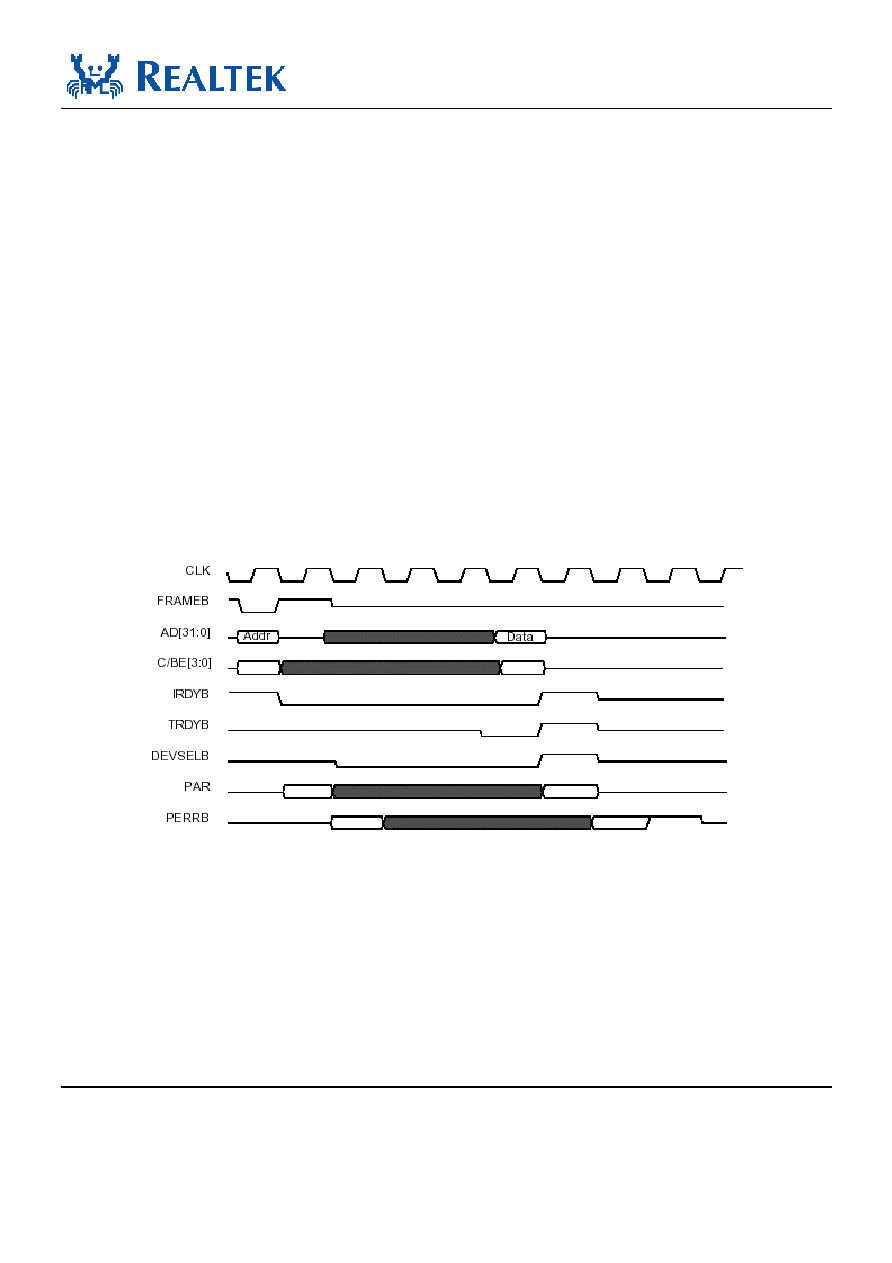
RTL8169SB(L)
Datasheet
Integrated Gigabit Ethernet Controller (NIC) 12
Track ID: JATR-1076-21 Rev. 1.5
6.2. PCI Bus Operation
6.2.1. Target
Read
A Target Read operation starts with the system generating FRAMEB, Address, and either an IO read
(0010b) or Memory Read (0110b) command. If the 32-bit address on the address bus matches the IO
address range specified in IOAR (for I/O reads) or the memory address range specified in MEM (for
memory reads), the RTL8169SB(L) will generate DEVSELB 2 clock cycles later (medium speed). The
system must tri-state the address bus, and convert the C/BE bus to byte enables after the address cycle. On
the 2nd cycle after the assertion of DEVSELB, all 32-bits of data and TRDYB will become valid. If
IRDYB is asserted at that time, TRDYB will be forced HIGH on the next clock for 1 cycle, and then
tri-stated.
If FRAMEB is asserted beyond the assertion of IRDYB, the RTL8169SB(L) will still make data available
as described above, but will also issue a Disconnect. That is, it will assert the STOPB signal with TRDYB.
STOPB will remain asserted until FRAMEB is detected as deasserted.
Figure 4. Target Read Operation
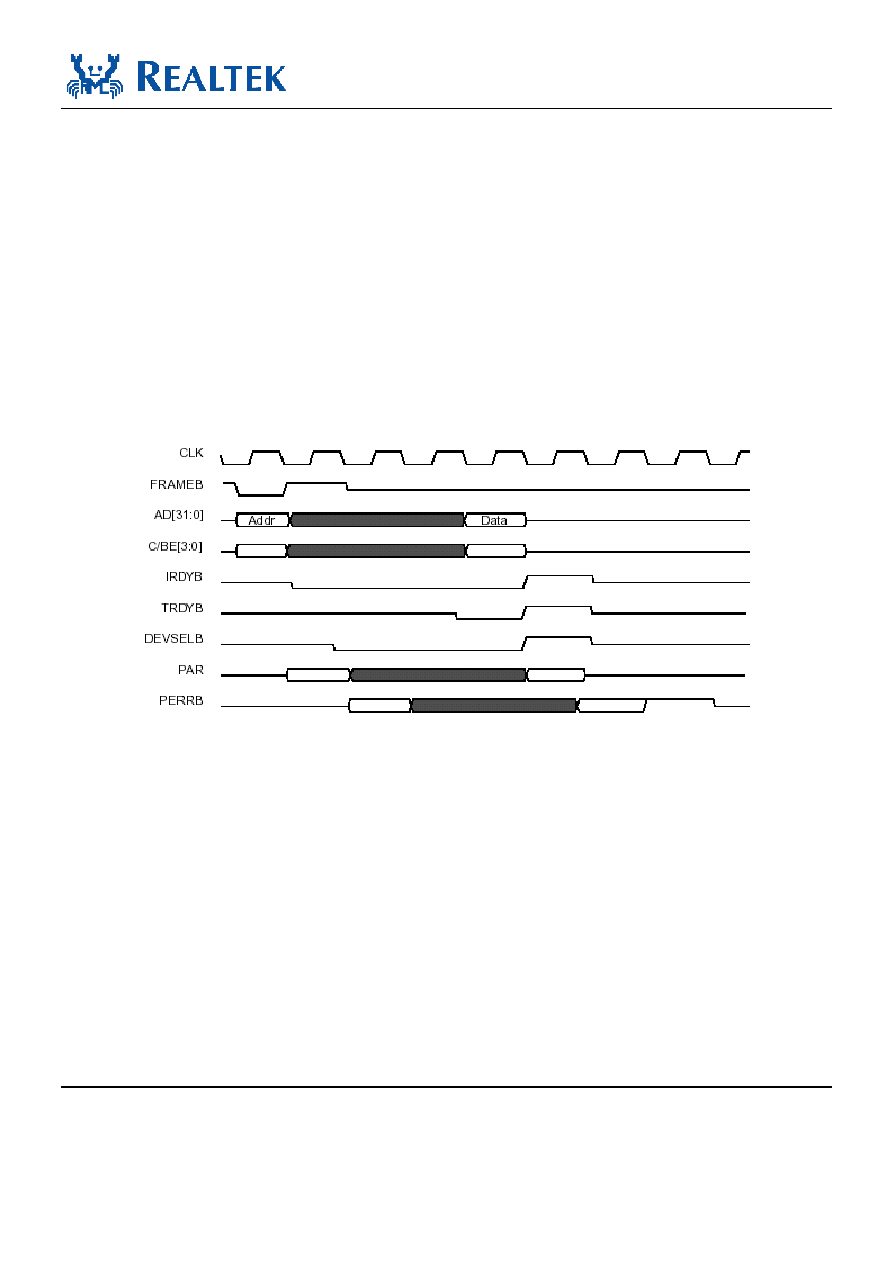
RTL8169SB(L)
Datasheet
Integrated Gigabit Ethernet Controller (NIC) 13
Track ID: JATR-1076-21 Rev. 1.5
6.2.2. Target
Write
A Target Write operation starts with the system generating FRAMEB, Address, and Command (0011b or
0111b). If the upper 24 bits on the address bus match IOAR (for I/O reads) or MEM (for memory reads),
the RTL8169SB(L) will generate DEVSELB 2 clock cycles later. On the 2nd cycle after the assertion of
DEVSELB, the device will monitor the IRDYB signal. If IRDYB is asserted at that time, the
RTL8169SB(L) will assert TRDYB. On the next clock the 32-bit double word will be latched in, and
TRDYB will be forced HIGH for 1 cycle and then tri-stated. Target write operations must be 32-bits wide.
If FRAMEB is asserted beyond the assertion of IRDYB, the RTL8169SB(L) will still latch the first double
word as described above, but will also issue a Disconnect. That is, it will assert the STOPB signal with
TRDYB. STOPB will remain asserted until FRAMEB is detected as deasserted.
Figure 5. Target Write Operation

RTL8169SB(L)
Datasheet
Integrated Gigabit Ethernet Controller (NIC) 14
Track ID: JATR-1076-21 Rev. 1.5
6.2.3. Master
Read
A Master Read operation starts with the RTL8169SB(L) asserting REQB. If GNTB is asserted within 2
clock cycles, FRAMEB, Address, and Command will be generated 2 clocks after REQB (Address and
FRAMEB for 1 cycle only). If GNTB is asserted 3 cycles or later, FRAMEB, Address, and Command will
be generated on the clock following GNTB.
The device will wait for 8 cycles for the assertion of DEVSELB. If DEVSELB is not asserted within
8 clocks, the device will issue a master abort by asserting FRAMEB HIGH for 1 cycle, and IRDYB will be
forced HIGH on the following cycle. Both signals will become tri-state on the cycle following their
deassertion.
On the clock edge after the generation of Address and Command, the address bus will become tri-state, and
the C/BE bus will contain valid byte enables. On the clock edge after FRAMEB was asserted, IRDYB will
be asserted (and FRAMEB will be deasserted if this is to be a single read operation). On the clock where
both TRDYB and DEVSELB are detected as asserted, data will be latched in (and the byte enables will
change if necessary). This will continue until the cycle following the deassertion of FRAMEB.
On the clock where the second to last read cycle occurs, FRAMEB will be forced HIGH (it will be
tri-stated 1 cycle later). On the next clock edge that the device detects TRDYB asserted, it will force
IRDYB HIGH. It too will be tri-stated 1 cycle later. This will conclude the read operation. The
RTL8169SB(L) will never force a wait state during a read operation.
Figure 6. Master Read Operation
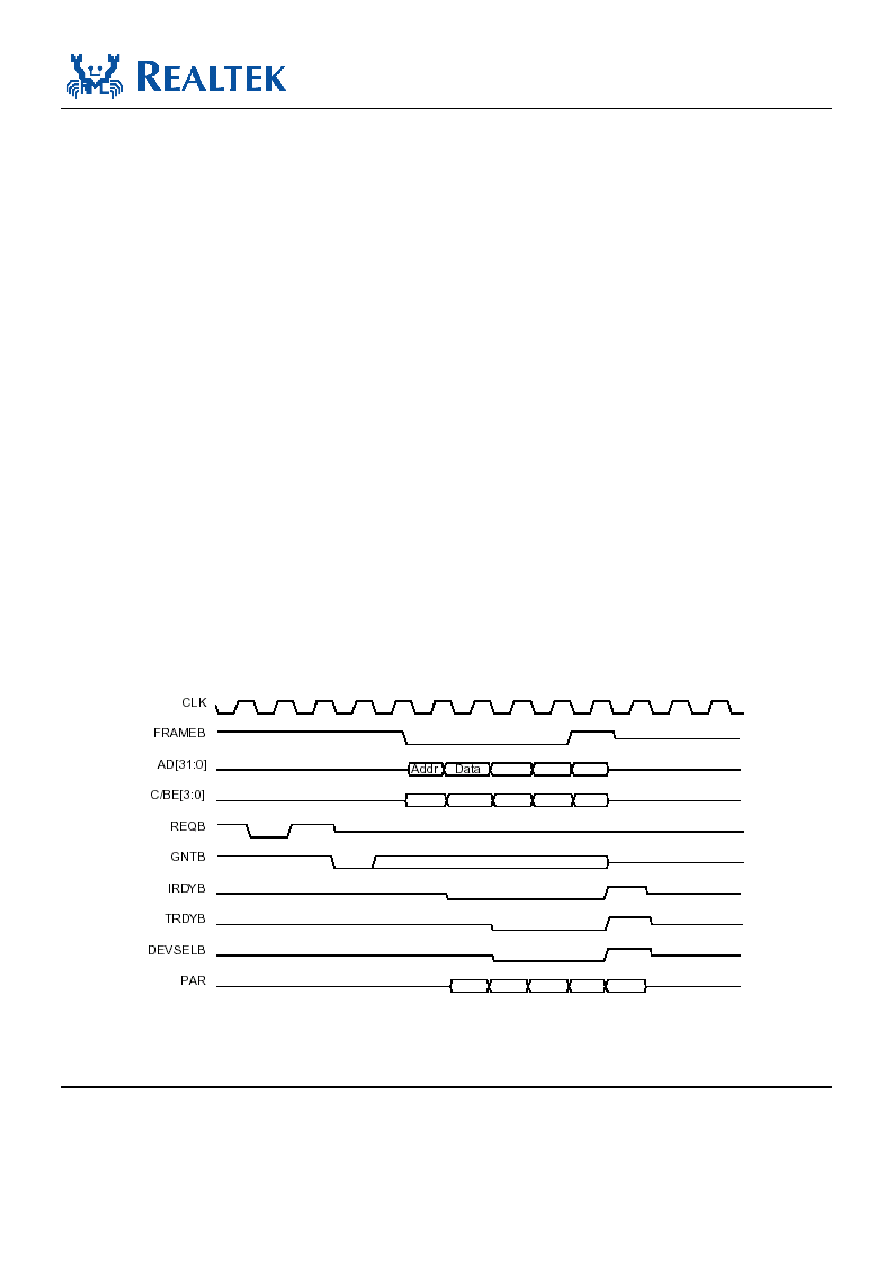
RTL8169SB(L)
Datasheet
Integrated Gigabit Ethernet Controller (NIC) 15
Track ID: JATR-1076-21 Rev. 1.5
6.2.4. Master
Write
A Master Write operation starts with the RTL8169SB(L) asserting REQB. If GNTB is asserted within 2
clock cycles, FRAMEB, Address, and Command will be generated 2 clocks after REQB (Address and
FRAMEB for 1 cycle only). If GNTB is asserted 3 cycles or later, FRAMEB, Address, and Command will
be generated on the clock following GNTB.
The device will wait for 8 cycles for the assertion of DEVSELB. If DEVSELB is not asserted within
8 clocks, the device will issue a Master Abort by asserting FRAMEB HIGH for 1 cycle. IRDYB will be
forced HIGH on the following cycle. Both signals will become tri-state on the cycle following their
deassertion.
On the clock edge after the generation of Address and Command, the data bus will become valid, and the
C/BE bus will contain valid byte enables. On the clock edge after FRAMEB was asserted, IRDYB will be
asserted (and FRAMEB will be deasserted if this is to be a single read operation). On the clock where both
TRDYB and DEVSELB are detected as asserted, valid data for the next cycle will become available (and
the byte enables will change if necessary). This will continue until the cycle following the deassertion of
FRAMEB.
On the clock where the second to last write cycle occurs, FRAMEB will be forced HIGH (it will be
tri-stated 1 cycle later). On the next clock edge that the device detects TRDYB asserted, it will force
IRDYB HIGH. It too will be tri-stated 1 cycle later. This will conclude the write operation. The
RTL8169SB(L) will never force a wait state during a write operation.
Figure 7. Master Write Operation

RTL8169SB(L)
Datasheet
Integrated Gigabit Ethernet Controller (NIC) 16
Track ID: JATR-1076-21 Rev. 1.5
6.2.5. Configuration
Access
Configuration register accesses are similar to target reads and writes in that they are single data word
transfers and are initiated by the system. For the system to initiate a Configuration access, it must also
generate IDSEL as well as the correct Command (1010b or 1011b) during the Address phase. The
RTL8169SB(L) will respond as it does during Target operations. Configuration reads must be 32-bits
wide, but writes may access individual bytes.
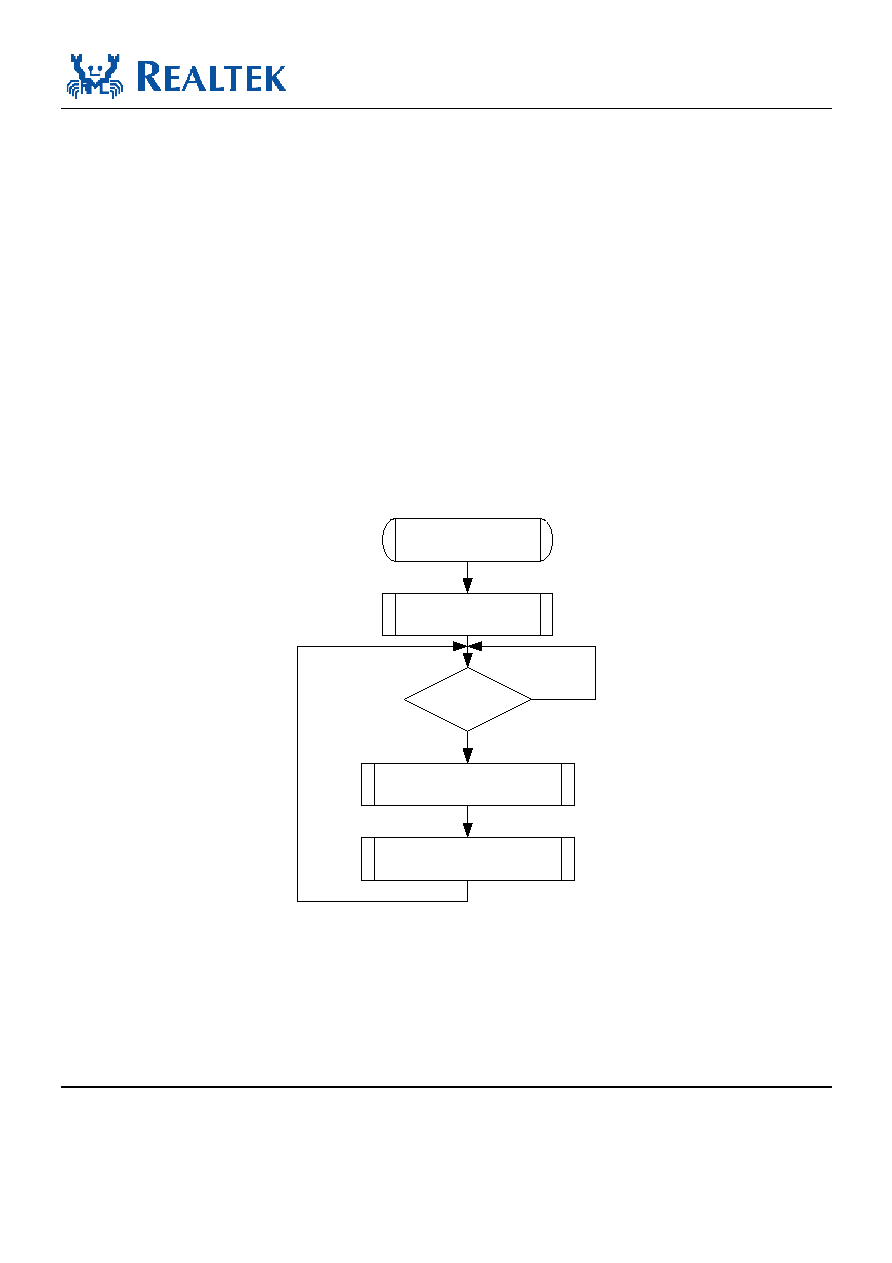
RTL8169SB(L)
Datasheet
Integrated Gigabit Ethernet Controller (NIC) 17
Track ID: JATR-1076-21 Rev. 1.5
6.3. LED
Functions
The RTL8169SB(L) supports 4 LED signals in 4 different configurable operation modes. The following
sections describe the different LED actions.
6.3.1. Link
Monitor
The Link Monitor senses the link integrity or if a station is down, such as LINK10, LINK100, LINK1000,
LINK10/100/1000, LINK10/ACT, LINK100/ACT, or LINK1000/ACT. Whenever link status is
established, the specific link LED pin is driven low. Once a cable is disconnected, the link LED pin is
driven high, indicating that no network connection exists.
6.3.2. Rx
LED
In 10/100/1000Mbps mode, blinking of the Rx LED indicates that receive activity is occurring.
Power On
Receiving
Packet?
LED = High
LED = High for (100 +- 10) ms
LED = Low for (12 +- 2) ms
No
Yes
Figure 8. Rx LED
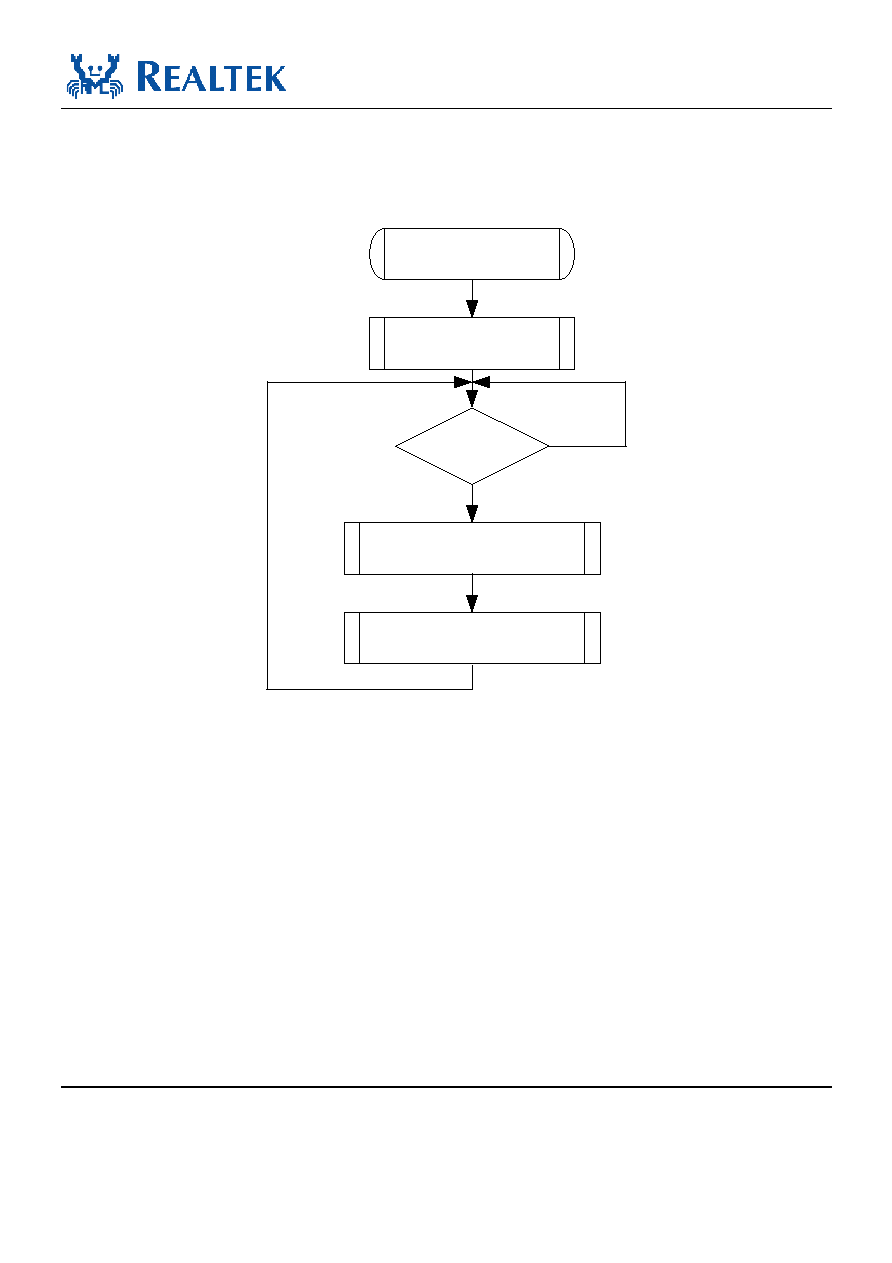
RTL8169SB(L)
Datasheet
Integrated Gigabit Ethernet Controller (NIC) 18
Track ID: JATR-1076-21 Rev. 1.5
6.3.3. Tx
LED
In 10/100/1000Mbps mode, blinking of the Tx LED indicates that transmit activity is occurring.
Power On
Transmitting
Packet?
LED = High
LED = High for (100 +- 10) ms
LED = Low for (12 +- 2) ms
No
Yes
Figure 9. Tx LED

RTL8169SB(L)
Datasheet
Integrated Gigabit Ethernet Controller (NIC) 19
Track ID: JATR-1076-21 Rev. 1.5
6.3.4. Tx/Rx
LED
In 10/100/1000Mbps mode, blinking of the Tx/Rx LED indicates that both transmit and receive activity is
occurring.
Power On
Tx/Rx Packet?
LED = High
LED = High for (100 +- 10) ms
LED = Low for (12 +- 2) ms
No
Yes
Figure 10. Tx/Rx LED

RTL8169SB(L)
Datasheet
Integrated Gigabit Ethernet Controller (NIC) 20
Track ID: JATR-1076-21 Rev. 1.5
6.3.5. LINK/ACT
LED
In 10/100/1000Mbps mode, blinking of the LINK/ACT LED indicates that the RTL8169SB(L) is linked
and operating properly. When this LED is high for extended periods, it indicates that a link problem exists.
Power On
Link?
LED = High
LED = Low
LED = Low for (12 +- 2) ms
No
Yes
Tx/Rx packet?
Yes
No
LED = High for (100 +- 10) ms
Figure 11. LINK/ACT LED

RTL8169SB(L)
Datasheet
Integrated Gigabit Ethernet Controller (NIC) 21
Track ID: JATR-1076-21 Rev. 1.5
6.4. PHY
Transceiver
6.4.1. PHY
Transmitter
In 10Mbps mode, the Tx MAC retrieves packet data from the Tx Buffer Manager and sends it out through
the transmitting physical layer interface. The transmit 4-bit nibbles (TXD[3:0]) clocked at 2.5MHz (TXC),
are serialized into 10Mbps serial data. Then, the 10Mbps serial data is converted into a
Manchester-encoded data stream and is transmitted onto the media by the DAC converter.
In 100Mbps mode, the transmitted 4-bit nibbles (TXD[3:0]) from the MAC, clocked at 25MHz (TXC), are
converted into 5B symbol code via 4B/5B coding technology, scrambling, and serializing before being
converted to 125MHz NRZ and NRZI signals. After that, the NRZI signal is passed to the MLT-3 encoder,
then to the DAC converter for transmission onto the media.
In 1000Mbps mode, the RTL8169SB(L)'s PCS layer receives data bytes from the MAC through the GMII
interface and performs the generation of continuous code-groups through 4D-PAM5 coding technology.
Then those code groups are passed through a waveform shaping filter to minimize EMI effects, and are
transmitted onto the 4-pair CAT5 cable at 125MBaud/s through a DAC.
6.4.2. PHY
Receiver
In MII (10Mbps) mode, the received differential signal is converted into a Manchester-encoded data
stream. The stream is processed with a Manchester decoder, and is de-serialized into 4-bit wide nibbles.
The 4-bit nibbles are presented to the MII interface at a clock speed of 2.5MHz. In 100Mbps mode, the
MLT-3 signal is processed with an ADC, equalizer, BLW (Baseline Wander) correction, timing recovery,
MLT-3 and NRZI decoder, descrambler, 4B/5B decoder, and then is presented to the MII interface in 4-bit
wide nibbles at a clock speed of 25MHz.
In GMII mode, the input signal from the media first passes through the on-chip sophisticated hybrid circuit
to subtract the transmitted signal from the input signal for effective reduction of near-end echo.
Afterwards, the received signal is processed with adaptive equalization, BLW (Baseline Wander)
correction, cross-talk cancellation, echo cancellation, timing recovery, error correction, and 4D-PAM5
decoding. Then the 8-bit wide data is recovered and is sent to the GMII interface at a clock speed of
125MHz. The Rx MAC retrieves the packet data from the receive MII/GMII interface and sends it to the
Rx Buffer Manager.

RTL8169SB(L)
Datasheet
Integrated Gigabit Ethernet Controller (NIC) 22
Track ID: JATR-1076-21 Rev. 1.5
6.5. Next
Page
If 1000Base-T mode is advertised, three additional Next Pages are automatically exchanged between the
two link partners. Users can set PHY Reg4.15 to 1 to manually exchange extra Next Pages via Reg7 and
Reg8 as defined in IEEE 802.3ab.
6.6. EEPROM
Interface
The RTL8169SB(L) requires the attachment of an external EEPROM. The 93C46 is a 1K-bit EEPROM
(the 93C56 is a 2K-bit EEPROM, the 93C66 is a 4K-bit EEPROM). The EEPROM interface provides the
ability for the RTL8169SB(L) to read from and write data to an external serial EEPROM device.
Values in the external EEPROM allow default fields in PCI configuration space and I/O space to be
overridden following a power-on or software EEPROM auto-load command. The RTL8169SB(L) will
auto-load values from the EEPROM. If the EEPROM is not present, the RTL8169SB(L) initialization uses
default values for the appropriate Configuration and Operational Registers. Software can read and write to
the EEPROM using bit-bang accesses via the 9346CR Register, or using PCI VPD. The interface consists
of EESK, EECS, EEDO, and EEDI.
Table 10. EEPROM Interface
EEPROM
Description
EECS
93C46 (93C56/93C66) chip select.
EESK
EEPROM serial data clock.
EEDI/Aux
Input data bus/Input pin to detect if Aux. Power exists or not on initial power-on.
This pin should be connected to Boot PROM. To support wakeup from ACPI D3cold
or APM power-down, this pin must be pulled high to Aux. Power via a resistor. If this
pin is not pulled high to Aux. Power, the RTL8169SB(L) assumes that no Aux. Power
exists.
EEDO
Output data bus

RTL8169SB(L)
Datasheet
Integrated Gigabit Ethernet Controller (NIC) 23
Track ID: JATR-1076-21 Rev. 1.5
6.7. Power
Management
The RTL8169SB(L) is compliant with ACPI (Rev 1.0, 1.0b, 2.0), PCI Power Management (Rev 1.1), and
Network Device Class Power Management Reference Specification (V1.0a), such as to support an
Operating System-Directed Power Management (OSPM) environment.
The RTL8169SB(L) can monitor the network for a Wakeup Frame, a Magic Packet, or a Re-LinkOk, and
notify the system via PME# when such a packet or event occurs. Then, the whole system can be restored to
a normal state to process incoming jobs.
When the RTL8169SB(L) is in power down mode (D1 ~ D3):
∑ The Rx state machine is stopped, and the RTL8169SB(L) monitors the network for wakeup events such
as a Magic Packet, Wakeup Frame, and/or Re-LinkOk, in order to wake up the system. When in power
down mode, the RTL8169SB(L) will not reflect the status of any incoming packets in the ISR register
and will not receive any packets into the Rx FIFO buffer.
∑ The FIFO status and packets that have already been received into the Rx FIFO before entering power
down mode are held by the RTL8169SB(L).
∑ Transmission is stopped. PCI bus master mode is stopped. The Tx FIFO buffer is held.
∑ After restoration to a D0 state, the RTL8169SB(L) transfers data that was not moved into the Tx FIFO
buffer during power down mode. Packets that were not transmitted completely last time are
re-transmitted.
The D3cold_support_PME bit (bit15, PMC register) and the Aux_I_b2:0 bits (bit8:6, PMC register) in PCI
configuration space depend on the existence of Aux power (bit15, PMC) = 1.
If EEPROM D3cold_support_PME bit (bit15, PMC) = 0, the above 4 bits are all 0's.
Example:
If EEPROM D3c_support_PME = 1:
∑ If aux. power exists, then PMC in PCI config space is the same as EEPROM PMC
(if EEPROM PMC = C2 F7, then PCI PMC = C2 F7)
∑ If aux. power is absent, then PMC in PCI config space is the same as EEPROM PMC except the above
4 bits are all 0's (if EEPROM PMC = C2 F7, then PCI PMC = 02 76)
In the above case, if wakeup support is desired when main power is off, it is suggested that the EEPROM
PMC be set to C2 F7 (Realtek EEPROM default value).

RTL8169SB(L)
Datasheet
Integrated Gigabit Ethernet Controller (NIC) 24
Track ID: JATR-1076-21 Rev. 1.5
If EEPROM D3c_support_PME = 0:
∑ If aux. power exists, then PMC in PCI config space is the same as EEPROM PMC
(if EEPROM PMC = C2 77, then PCI PMC = C2 77)
∑ If aux. power is absent, then PMC in PCI config space is the same as EEPROM PMC except the above
4 bits are all 0's (if EEPROM PMC = C2 77, then PCI PMC = 02 76)
In the above case, if wakeup support is not desired when main power is off, it is suggested that the
EEPROM PMC be set to 02 76.
Link Wakeup occurs only when the following conditions are met:
∑ The LinkUp bit (CONFIG3#4) is set to 1, the PMEn bit (CONFIG1#0) is set to 1, and the PME# can be
asserted in the current power state.
Magic Packet Wakeup occurs only when the following conditions are met:
∑ The destination address of the received Magic Packet is acceptable to the RTL8169SB(L), e.g. a
broadcast, multicast, or unicast packet addressed to the current RTL8169SB(L) adapter.
∑ The received Magic Packet does not contain a CRC error.
∑ The Magic bit (CONFIG3#5) is set to 1, the PMEn bit (CONFIG1#0) is set to 1, and the PME# can be
asserted in the current power state.
∑ The Magic Packet pattern matches, i.e. 6 * FFh + MISC (can be none) + 16 * DID (Destination ID) in
any part of a valid (Fast) Ethernet packet.
A Wakeup Frame event occurs only when the following conditions are met:
∑ The destination address of the received Wakeup Frame is acceptable to the RTL8169SB(L), e.g. a
broadcast, multicast, or unicast address to the current RTL8169SB(L) adapter.
∑ The received Wakeup Frame does not contain a CRC error.
∑ The PMEn bit (CONFIG1#0) is set to 1.
∑ The 16-bit CRC* of the received Wakeup Frame matches the 16-bit CRC* of the sample Wakeup
Frame pattern given by the local machine's OS. Or, the RTL8169SB(L) is configured to allow direct
packet wakeup, e.g. a broadcast, multicast, or unicast network packet.
*16-bit CRC: The RTL8169SB(L) supports two normal wakeup frames (covering 64 mask bytes from offset
0 to 63 of any incoming network packet) and three long wakeup frames (covering 128 mask bytes from
offset 0 to 127 of any incoming network packet).

RTL8169SB(L)
Datasheet
Integrated Gigabit Ethernet Controller (NIC) 25
Track ID: JATR-1076-21 Rev. 1.5
The PME# signal is asserted only when the following conditions are met:
∑ The PMEn bit (bit0, CONFIG1) is set to 1.
∑ The PME_En bit (bit8, PMCSR) in PCI Configuration Space is set to 1.
∑ The RTL8169SB(L) may assert PME# in the current power state or in isolation state, depending on
the PME_Support (bit15-11) setting of the PMC register in PCI Configuration Space.
∑ A Magic Packet, LinkUp, or Wakeup Frame has been received.
∑ Writing a 1 to the PME_Status (bit15) of the PMCSR register in the PCI Configuration Space clears
this bit and causes the RTL8169SB(L) to stop asserting a PME# (if enabled).
When the device is in power down mode, e.g. D1-D3, the IO, MEM, and Boot ROM spaces are all
disabled. After a RST# assertion, the device's power state is restored to D0 automatically if the original
power state was D3
cold
. There is no hardware delay at the device's power state transition. When in ACPI
mode, the device does not support PME (Power Management Enable) from D0 (this is the Realtek default
setting of the PMC register auto-loaded from EEPROM). The setting may be changed from the EEPROM,
if required. The RTL8169SB(L) also supports the legacy LAN WAKE-UP function. The LWAKE pin is
used to notify legacy motherboards to execute the wake-up process whenever the device receives a wakeup
event, such as Magic Packet.
The LWAKE signal is asserted according to the following settings:
1. LWPME bit (bit4, CONFIG4):
∑ LWAKE can only be asserted when PMEB is asserted and ISOLATEB is low.
∑ LWAKE is asserted whenever a wakeup event occurs.
2. Bit1 of DELAY byte (offset 1Fh, EEPROM):
∑ LWAKE signal is enabled.
∑ LWAKE signal is disabled.

RTL8169SB(L)
Datasheet
Integrated Gigabit Ethernet Controller (NIC) 26
Track ID: JATR-1076-21 Rev. 1.5
7. Characteristics
7.1. Absolute Maximum Ratings
WARNING: Absolute maximum ratings are limits beyond which permanent damage may be caused to the
device, or device reliability will be affected. All voltages are specified reference to GND unless otherwise
specified.
Table 11. Absolute Maximum Ratings
Description/Symbol
Minimum
Maximum
Unit
Supply Voltage (VDD33, AVDDH)
-0.5
4
V
Supply Voltage (AVDDL)
-0.5
3
V
Supply Voltage (VDD12, VDD12A)
-0.5
1.5
V
Input Voltage (DCinput)
-0.5
VDD33 + 0.5
V
Output Voltage (DCoutput)
-0.5
VDD33 + 0.5
V
Storage Temperature
-55
+125
∞C
7.2. Recommended Operating Conditions
Table 12. Recommended Operating Conditions
Description
Pins
Minimum
Typical
Maximum
Unit
VDD33,
AVDDH
3.0 3.3 3.6 V
AVDDL 2.
32 2.5 2.67 V
Supply Voltage VDD
VDD12,
VDD12A
1.13 1.2 1.28 V
Ambient Temperature T
A
0 70
∞C
Maximum Junction
Temperature
125
∞C
7.3. Crystal
Requirements
Table 13. Crystal Requirements
Symbol
Description/Condition
Minimum
Typical
Maximum
Unit
F
ref
Parallel resonant crystal reference frequency,
fundamental mode, AT-cut type.
25
MHz
F
ref
Stability
Parallel resonant crystal frequency stability,
fundamental mode, AT-cut type. T
a
=25
∞C.
-50 +50
ppm
F
ref
Tolerance
Parallel resonant crystal frequency tolerance,
fundamental mode, AT-cut type.
T
a
=-20
∞C ~+70∞C.
-30 +30
ppm

RTL8169SB(L)
Datasheet
Integrated Gigabit Ethernet Controller (NIC) 27
Track ID: JATR-1076-21 Rev. 1.5
Symbol
Description/Condition
Minimum
Typical
Maximum
Unit
F
ref
Duty Cycle
Reference clock input duty cycle
40
60
%
C
L
Load Capacitance
27
pF
ESR Equivalent
Series
Resistance
10
DL
Drive Level
0.5
mW
7.4. Thermal
Characteristics
Table 14. Thermal Characteristics
Parameter
Minimum
Maximum
Units
Storage temperature
-55
+125
∞C
Operating temperature
0
70
∞C
7.5. DC
Characteristics
Table 15. DC Characteristics
Symbol
Parameter
Conditions
Minimum
Typical
Maximum
Units
VDD33 3.3V
Supply
Voltage
3.0
3.3
3.6
V
AVDDL 2.5V
Supply
Voltage
2.32
2.5
2.67
V
VDD12,
VDD12A
1.2V Supply Voltage
1.13
1.2
1.28
V
Voh
Minimum High Level
Output Voltage
Ioh = -8mA 0.9
*
VDD33
VDD33
V
Vol
Maximum Low Level
Output Voltage
Iol = 8mA
0.1
*
VDD33
V
Vih
Minimum High Level
Input Voltage
0.5
*
VDD33
VDD33+0.5
V
Vil
Maximum Low Level
Input Voltage
-0.5
0.3
*
VDD33
V
Iin Input
Current
Vin =VDD33 or
GND
-1.0 1.0 uA
Ioz
Tri-State Output
Leakage Current
Vout =VDD33 or
GND
-10 10 uA
Icc33
Average Operating
Supply Current from
3.3V
TBD
mA
Icc12
Average Operating
Supply Current from
1.2V
TBD
mA

RTL8169SB(L)
Datasheet
Integrated Gigabit Ethernet Controller (NIC) 28
Track ID: JATR-1076-21 Rev. 1.5
7.6. AC
Characteristics
7.6.1. Serial EEPROM Interface Timing
93C46(64*16)/93C56(128*16)/93C66(256*16)
EESK
EECS
EEDI
EEDO
1
1
0
An
A2
A0
A1
Dn
D1 D0
EESK
(Read)
(Write)
(Read)
(Write)
0
tcs
EESK
EECS
EEDI
EEDO
1
1
0
An
A0
...
Dn
tcs
...
D0
BUSY
READY
High Impedance
High Impedance
twp
EECS
EEDI
EEDO
EEDO
(Read)
(Program)
STATUS VALID
tsk
tskh
tskl
tcss
tdis
tdih
tdos
tdoh
tcsh
tsv
Figure 12. Serial EEPROM Interface Timing
Table 16. EEPROM Access Timing Parameters
Symbol
Parameter
EEPROM Type
Min.
Max.
Unit
tcs
Minimum CS Low Time
9346/9356(9366)
1000/250
ns
twp Write
Cycle
Time
9346/9356(9366)
10/10 ms
tsk
SK Clock Cycle Time
9346/9356(9366)
4/1
µs
tskh SK
High
Time
9346/9356(9366) 1000/500
ns
tskl SK
Low
Time
9346/9356(9366) 1000/250
ns

RTL8169SB(L)
Datasheet
Integrated Gigabit Ethernet Controller (NIC) 29
Track ID: JATR-1076-21 Rev. 1.5
Symbol
Parameter
EEPROM Type
Min.
Max.
Unit
tcss CS
Setup
Time
9346/9356(9366) 200/50
ns
tcsh CS
Hold
Time
9346/9356(9366) 0/0
ns
tdis DI
Setup
Time
9346/9356(9366) 400/50
ns
tdih DI
Hold
Time
9346/9356(9366) 400/100
ns
tdos DO
Setup
Time
9346/9356(9366) 2000/500
ns
tdoh DO
Hold
Time
9346/9356(9366)
2000/500 ns
tsv CS
to
Status
Valid
9346/9356(9366)
1000/500 ns
7.7. PCI Bus Operation Timing
7.7.1. PCI Bus Timing Parameters
Table 17. PCI Bus Timing Parameters
66MHz
33MHz
Symbol
Parameter
Min
Max
Min
Symbol
Parameter
T val
CLK to Signal Valid
Delay-bused signals
2 6 2
11 ns
T val(ptp)
CLK to Signal Valid
Delay-point to point
2 6 2
12 ns
T on
Float to Active Delay
2
2
ns
T off
Active to Float Delay
14
28
ns
T su
Input Setup Time to
CLK-bused signals
3 7 ns
T su(ptp)
Input Setup Time to
CLK-point to point
5 10 ns
T h
Input Hold Time from
CLK
0 0 ns
T rst
Reset active time after
power stable
1 1 ms
T rst-clk
Reset active time after
CLK STABLE
100 100 µs
T rst-off
Reset Active to Output
Float delay
40 40 ns
T rhfa
RSTB High to First
configuration Access
2^25 2^25 clocks
T rhff
RSTB High to First
FRAMEB assertion
5 5 clocks

RTL8169SB(L)
Datasheet
Integrated Gigabit Ethernet Controller (NIC) 30
Track ID: JATR-1076-21 Rev. 1.5
CLK
OUTPUT
DELAY
Tri-State
OUTPUT
V_th
V_tl
V_test
V_trise, V_tfall
T_off
T_val
T_on
V_test
V_test
Figure 13. Output Timing Measurement Conditions
CLK
INPUT
V_th
V_tl
V_test
V_test
T_su
V_th
V_tl
T_h
V_test
inputs valid
V_max
Figure 14. Input Timing Measurement Conditions
Table 18. Measurement Condition Parameters
Symbol
Level
Units
Vth
0.6Vcc V
Vtf
0.2Vcc V
Vtest
0.4Vcc V
Vtrise
0.285Vcc V
Vtfall
0.615Vcc V
Vmax
0.4Vcc V
Input Signal Edge Rate
1
V/ns
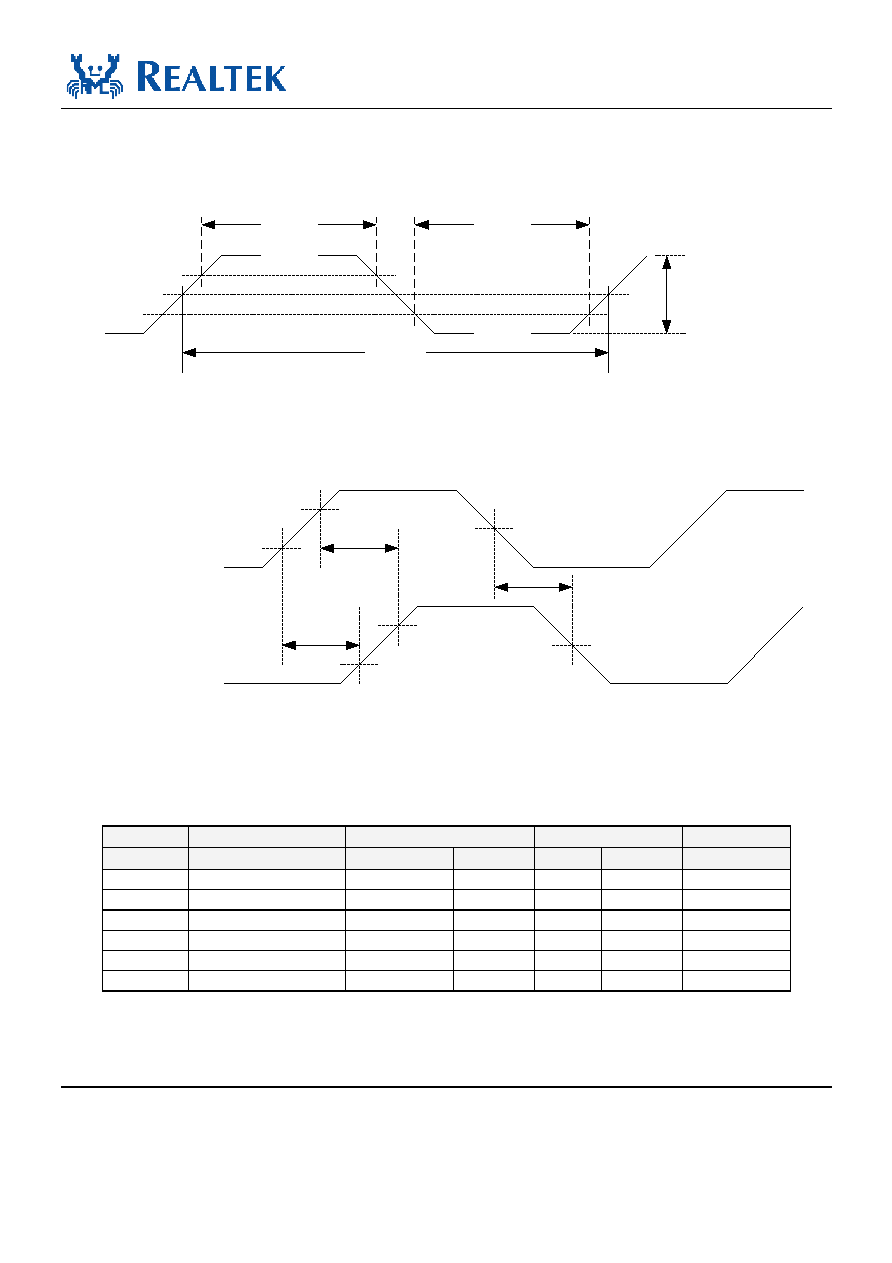
RTL8169SB(L)
Datasheet
Integrated Gigabit Ethernet Controller (NIC) 31
Track ID: JATR-1076-21 Rev. 1.5
7.7.2. PCI
Clock
Specification
0.6Vcc
0.2Vcc
0.4Vcc, peak-to-peak
(minimum)
0.3Vcc
T_high
T_low
T_cyc
0.5Vcc
0.4Vcc
Figure 15. 3.3V Clock Waveform
CLK (@ Device #1)
CLK (@ Device #2)
T_skew
T_skew
T_skew
V_ih
V_ih
V_il
V_il
V_test
V_test
Figure 16. Clock Skew Diagram
Table 19. Clock and Reset Specifications
66MHz
33MHz
Symbol
Parameter
Min
Max
Min
Symbol
Parameter
Tcyc CLK
Cycle
Time
15
30 30 ns
Thigh CLK
High
Time
6
11
ns
Tlow CLK
Low
Time
6
11
ns
--
CLK Slew Rate
1.5
4
1
4
V/ns
-- RST#
Slew
Rate
50
- 50 - mV/ns
Tskew
CLK
Skew
1 2 ns
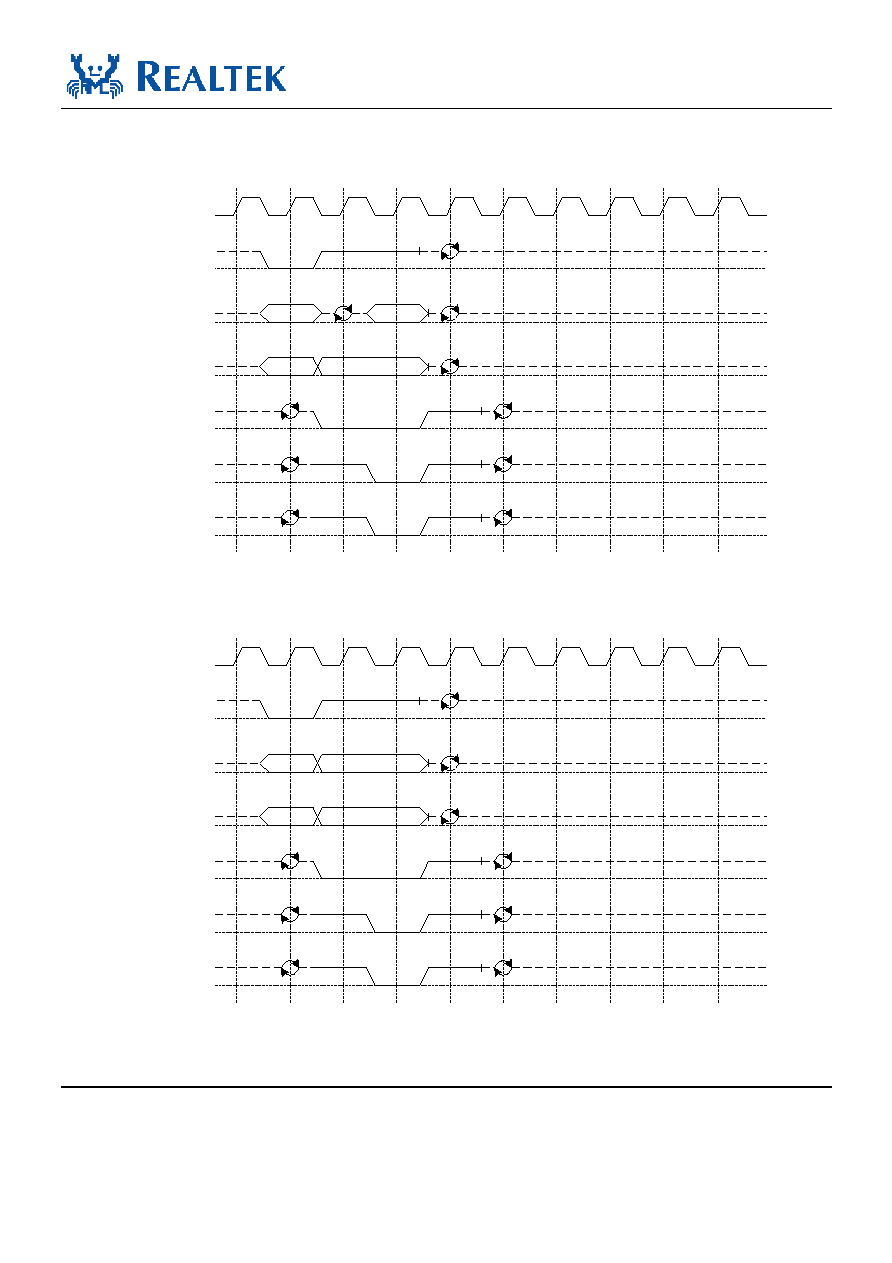
RTL8169SB(L)
Datasheet
Integrated Gigabit Ethernet Controller (NIC) 32
Track ID: JATR-1076-21 Rev. 1.5
7.7.3. PCI
Transactions
DEVSELB
C/BE3-0B
IRDYB
TRDYB
AD31-0
ADDRESS
CLK
1
2
3
4
5
6
7
8
9
FRAMEB
10
DATA
BUS CMD
BE3-0B
Figure 17. I/O Read
DEVSELB
C/BE3-0B
IRDYB
TRDYB
AD31-0
ADDRESS
CLK
1
2
3
4
5
6
7
8
9
FRAMEB
10
DATA
BUS CMD
BE3-0B
Figure 18. I/O Write
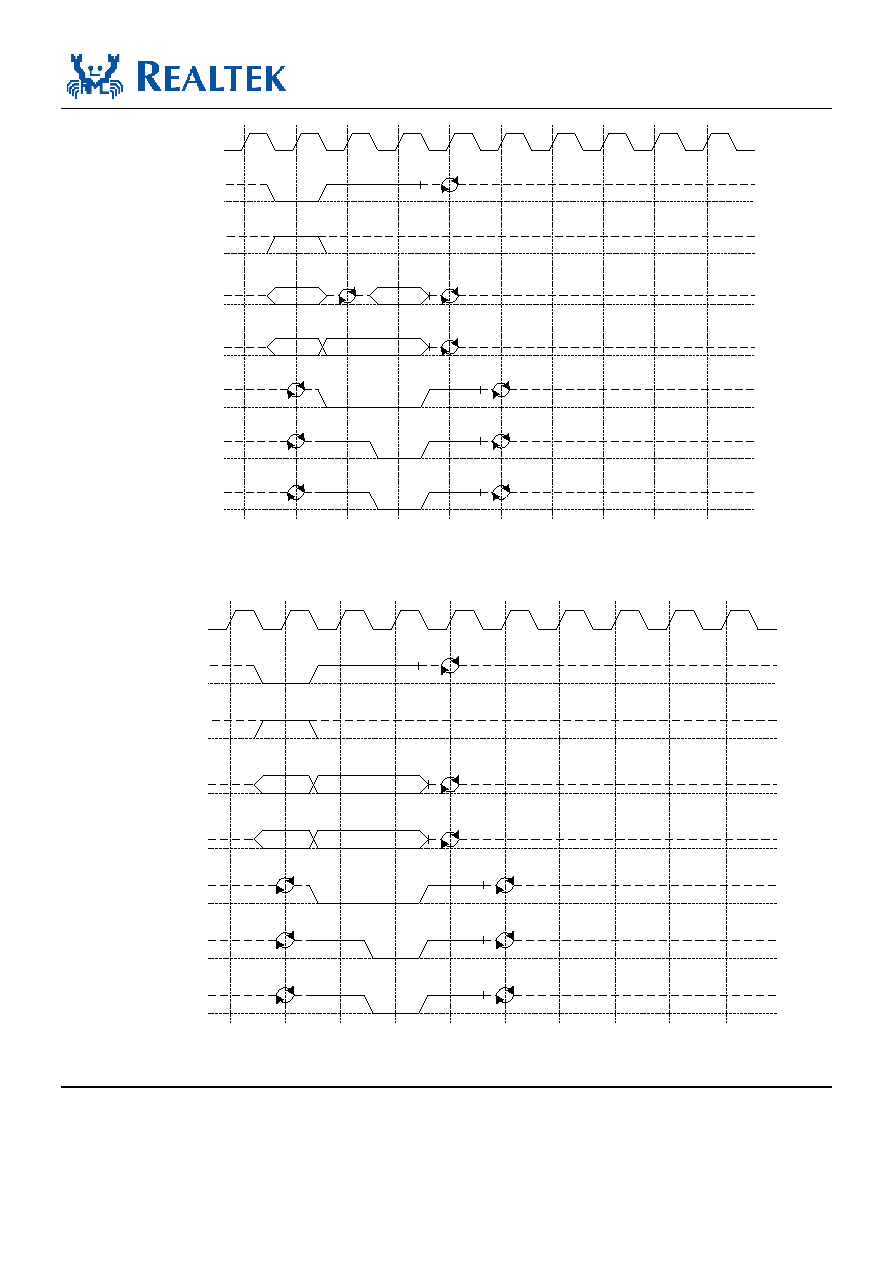
RTL8169SB(L)
Datasheet
Integrated Gigabit Ethernet Controller (NIC) 33
Track ID: JATR-1076-21 Rev. 1.5
DEVSELB
C/BE3-0B
IRDYB
TRDYB
AD31-0
ADDRESS
CLK
1
2
3
4
5
6
7
8
9
FRAMEB
10
DATA
BUS CMD
BE3-0B
IDSEL
Figure 19. Configuration Read
DEVSELB
C/BE3-0B
IRDYB
TRDYB
AD31-0
ADDRESS
CLK
1
2
3
4
5
6
7
8
9
FRAMEB
10
DATA
BUS CMD
BE3-0B
IDSEL
Figure 20. Configuration Write
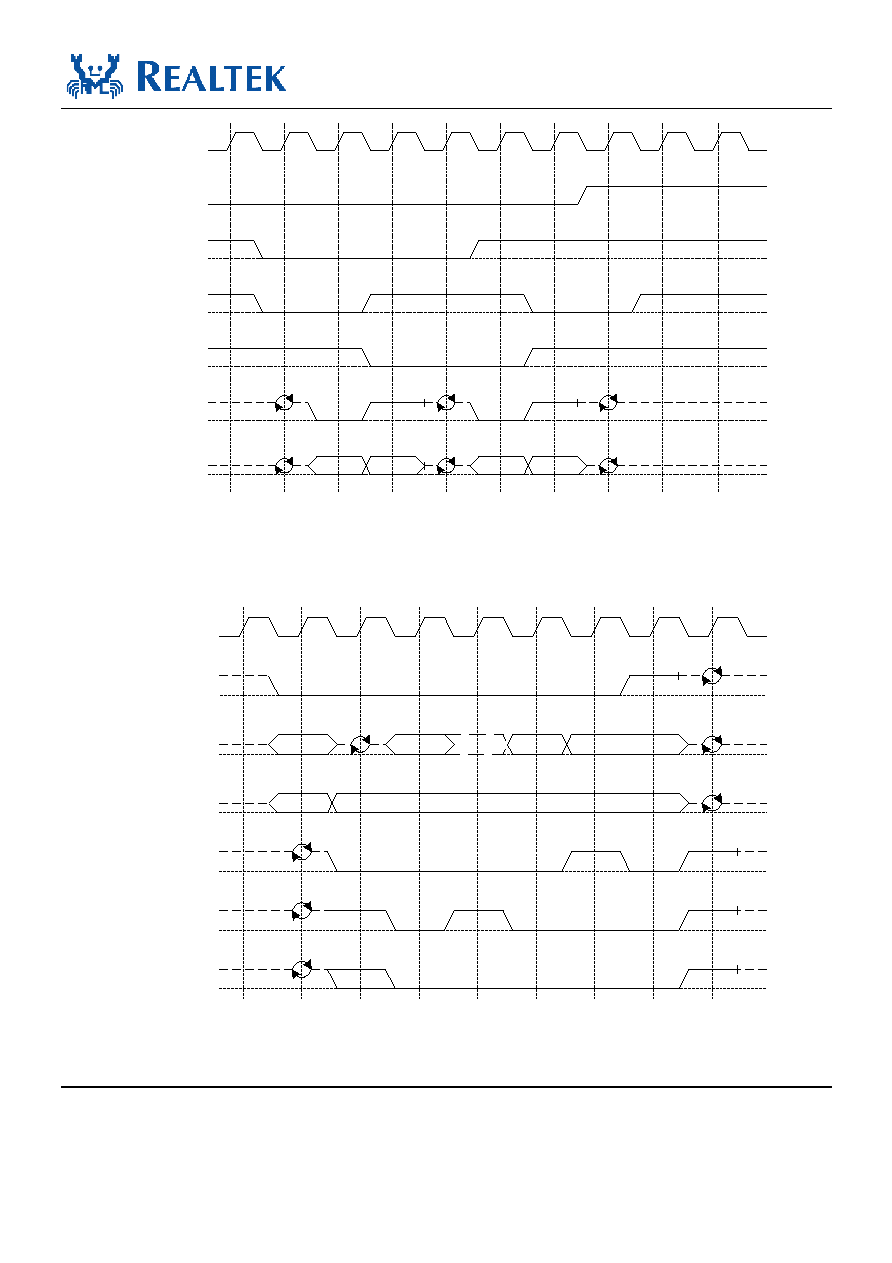
RTL8169SB(L)
Datasheet
Integrated Gigabit Ethernet Controller (NIC) 34
Track ID: JATR-1076-21 Rev. 1.5
ADDRESS
DATA
ADDRESS
DATA
AD
GNTB-A
GNTB-B
FRAMEB
REQB-B
CLK
1
2
3
4
5
6
7
8
9
REQB-A
10
Figure 21. Bus Arbitration
DEVSELB
IRDYB
TRDYB
WAIT
DATA TRANSFER
WAIT
WAIT
DATA TRANSFER
DATA TRANSFER
AD31-0
ADDRESS
DATA-1
DATA-2
DATA-3
CLK
1
2
3
4
5
6
7
8
9
FRAMEB
C/BE3-0B
BUS CMD
BE3-0B
Figure 22. Memory Read Below 4GB

RTL8169SB(L)
Datasheet
Integrated Gigabit Ethernet Controller (NIC) 35
Track ID: JATR-1076-21 Rev. 1.5
DEVSELB
C/BE3-0B
IRDYB
TRDYB
AD31-0
ADDRESS
DATA-1
DATA-2
DATA-3
BUS CMD BE3-0B-1 BE3-0B-2
CLK
1
2
3
4
5
6
7
8
9
FRAMEB
WAIT
DATA TRANSFER
WAIT
WAIT
DATA TRANSFER
DATA TRANSFER
BE3-0B-3
Figure 23. Memory Write Below 4GB
DEVSELB
IRDYB
TRDYB
CLK
1
2
3
4
5
6
7
8
9
FRAMEB
STOPB
Figure 24. Target Initiated Termination - Disconnect
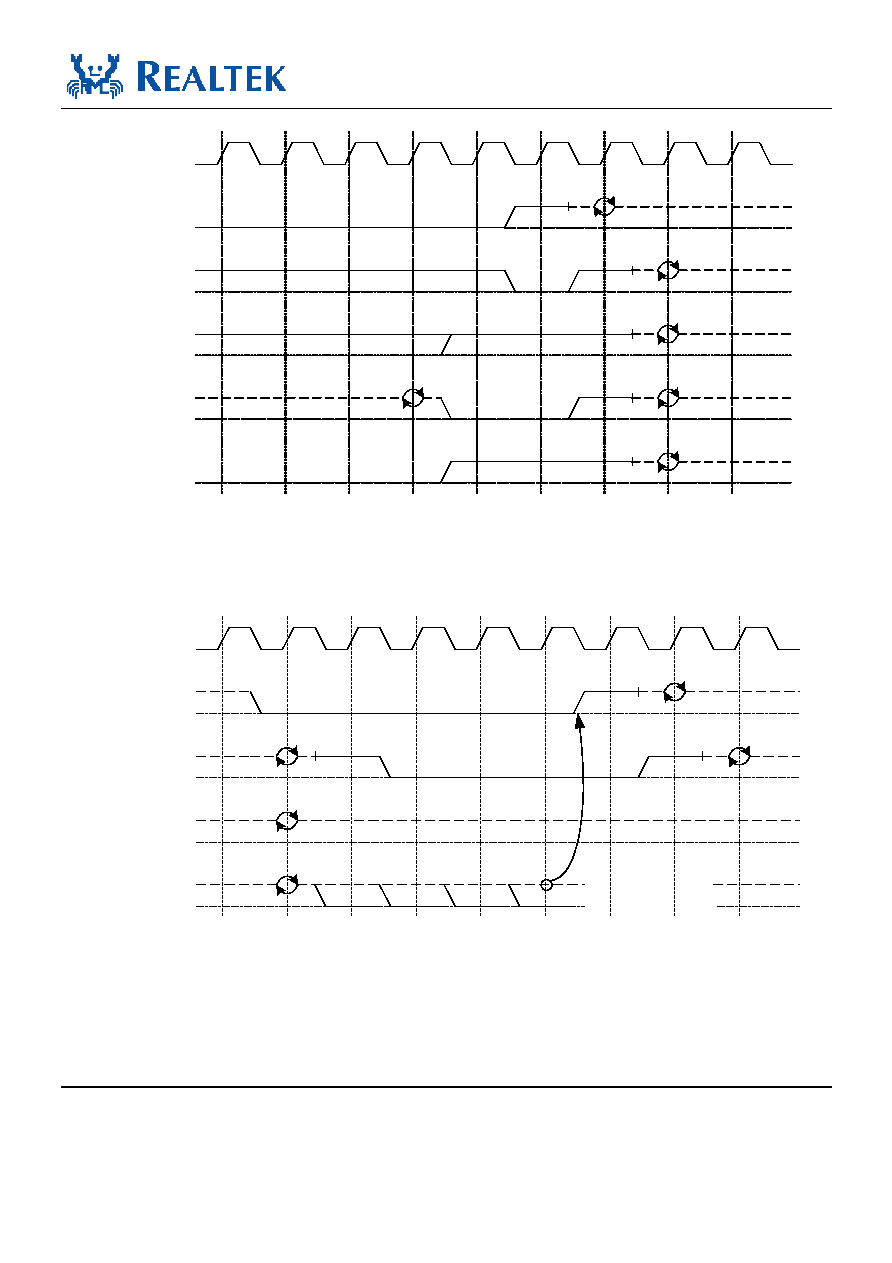
RTL8169SB(L)
Datasheet
Integrated Gigabit Ethernet Controller (NIC) 36
Track ID: JATR-1076-21 Rev. 1.5
DEVSELB
IRDYB
TRDYB
CLK
1
2
3
4
5
6
7
8
9
FRAMEB
STOPB
Figure 25. Target Initiated Termination - Abort
DEVSELB
IRDYB
TRDYB
CLK
1
2
3
4
5
6
7
8
9
FRAMEB
FAST
SUB
SLOW
MED
NO RESPONSE
ACKNOWLEDGE
Figure 26. Master Initiated Termination - Abort
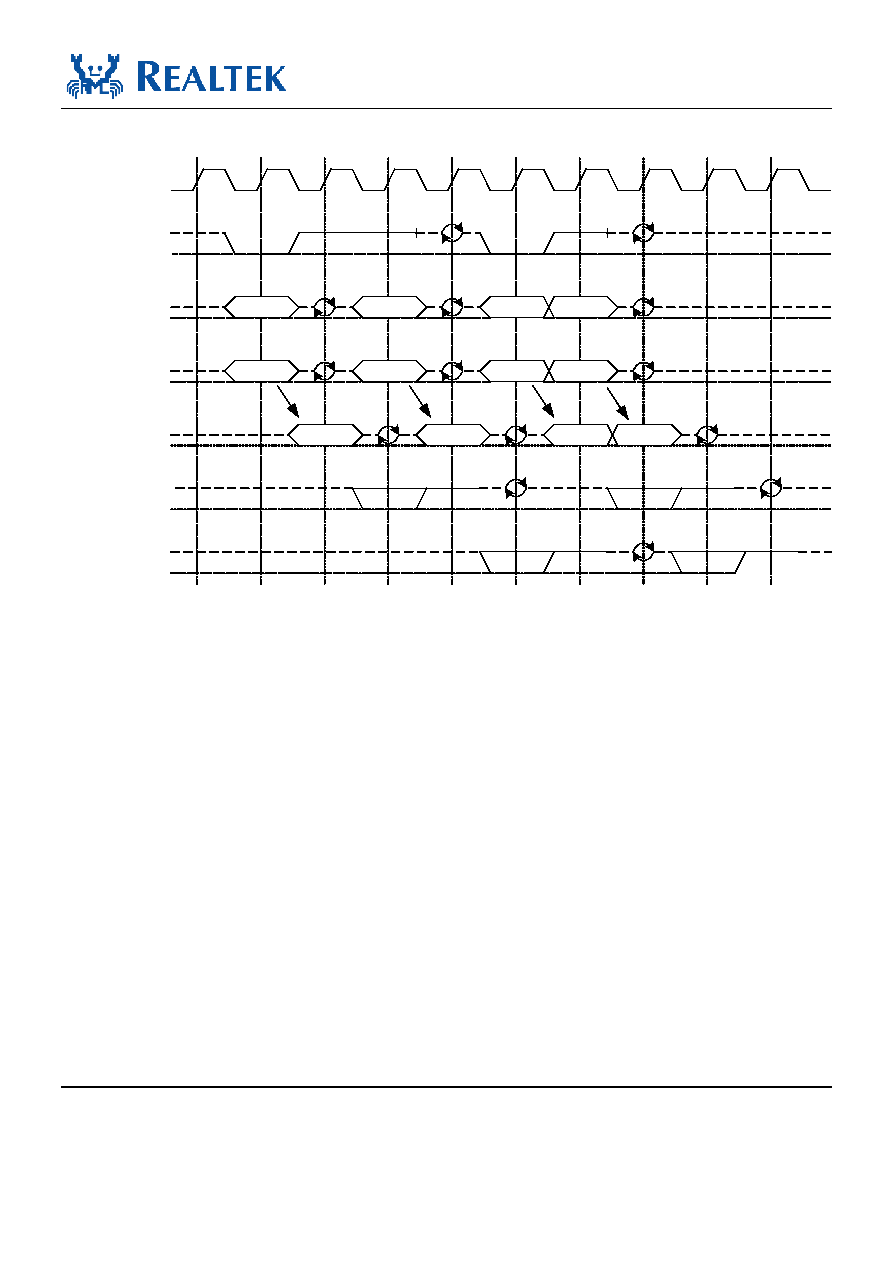
RTL8169SB(L)
Datasheet
Integrated Gigabit Ethernet Controller (NIC) 37
Track ID: JATR-1076-21 Rev. 1.5
BUS CMD
ADDRESS
DATA
ADDRESS
DATA
PERR#
CLK
1
2
3
4
5
6
7
8
9
FRAMEB
1
0
PAR/PAR64
AD
C/BE#
SERR#
BE#
BUS CMD
BE#
Figure 27. Parity Operation ≠ One Example

RTL8169SB(L)
Datasheet
Integrated Gigabit Ethernet Controller (NIC) 38
Track ID: JATR-1076-21 Rev. 1.5
DEVSELB
C/BE3-0B
IRDYB
TRDYB
AD31-0
LO-ADDR
CLK
1
2
3
4
5
6
7
8
9
FRAMEB
WA
I
T
D
A
TA TR
AN
SFER
WA
I
T
WA
I
T
D
A
TA TR
AN
SFER
D
A
TA TR
AN
SFER
10
BUS CMD
BE3-0B
DATA-1
DATA-2
DATA-3
HI-ADDR
DAC CMD
Figure 28. Memory Read Above 4GB (DAC)
DEVSELB
C/BE3-0B
IRDYB
TRDYB
AD31-0
LO-ADDR
DATA-1
DATA-2
DATA-3
BUS CMD BE3-0B-1 BE3-0B-2
CLK
1
2
3
4
5
6
7
8
9
FRAMEB
WAI
T
DAT
A
T
R
ANSF
ER
WAI
T
WAI
T
DAT
A
T
R
ANSF
ER
DAT
A
T
R
ANSF
ER
BE3-0B-3
10
HI-ADDR
DAC CMD
Figure 29. Memory Write Above 4GB (DAC)

RTL8169SB(L)
Datasheet
Integrated Gigabit Ethernet Controller (NIC) 39
Track ID: JATR-1076-21 Rev. 1.5
8. Mechanical
Dimensions
8.1. 128-Pin QFP Mechanical Dimensions
See the Mechanical Dimensions notes on the next page.

RTL8169SB(L)
Datasheet
Integrated Gigabit Ethernet Controller (NIC) 40
Track ID: JATR-1076-21 Rev. 1.5
8.2. Notes for 128-Pin QFP Dimensions
Symbol Dimensions in inches
Dimensions in mm
Notes
:
Min Typical Max Min Typical
Max
1. Dimensions D & E do not include interlead flash.
A
- -
0.134
- -
3.40
2. Dimension b does not include dambar
protrusion/intrusion.
A1
0.004 0.010 0.036 0.10 0.25
0.91
3. Controlling dimension: Millimeter
A2
0.102 0.112 0.122 2.60 2.85
3.10
4. General appearance spec. Should be based on final
visual inspection.
b
0.005 0.009 0.013 0.12 0.22
0.32
c
0.002 0.006 0.010 0.05 0.15
0.25
D
0.541 0.551 0.561 13.75 14.00 14.25
TITLE: 128 QFP (14x20 mm) PACKAGE OUTLINE
E
0.778 0.787 0.797 19.75 20.00 20.25
-CU L/F, FOOTPRINT 3.2 mm
e
0.010 0.020 0.030 0.25 0.5
0.75
LEADFRAME MATERIAL
HD
0.665 0.677 0.689 16.90 17.20 17.50
APPROVE DOC.
NO.
HE
0.902 0.913 0.925 22.90 23.20 23.50
VERSION
L
0.027 0.035 0.043 0.68 0.88
1.08
PAGE
L1
0.053 0.063 0.073 1.35 1.60
1.85
CHECK
DWG NO.
Q128 - 1
y
- -
0.004
- -
0.10
DATE
0∞ - 12∞ 0∞ - 12∞
REALTEK SEMICONDUCTOR CORP.
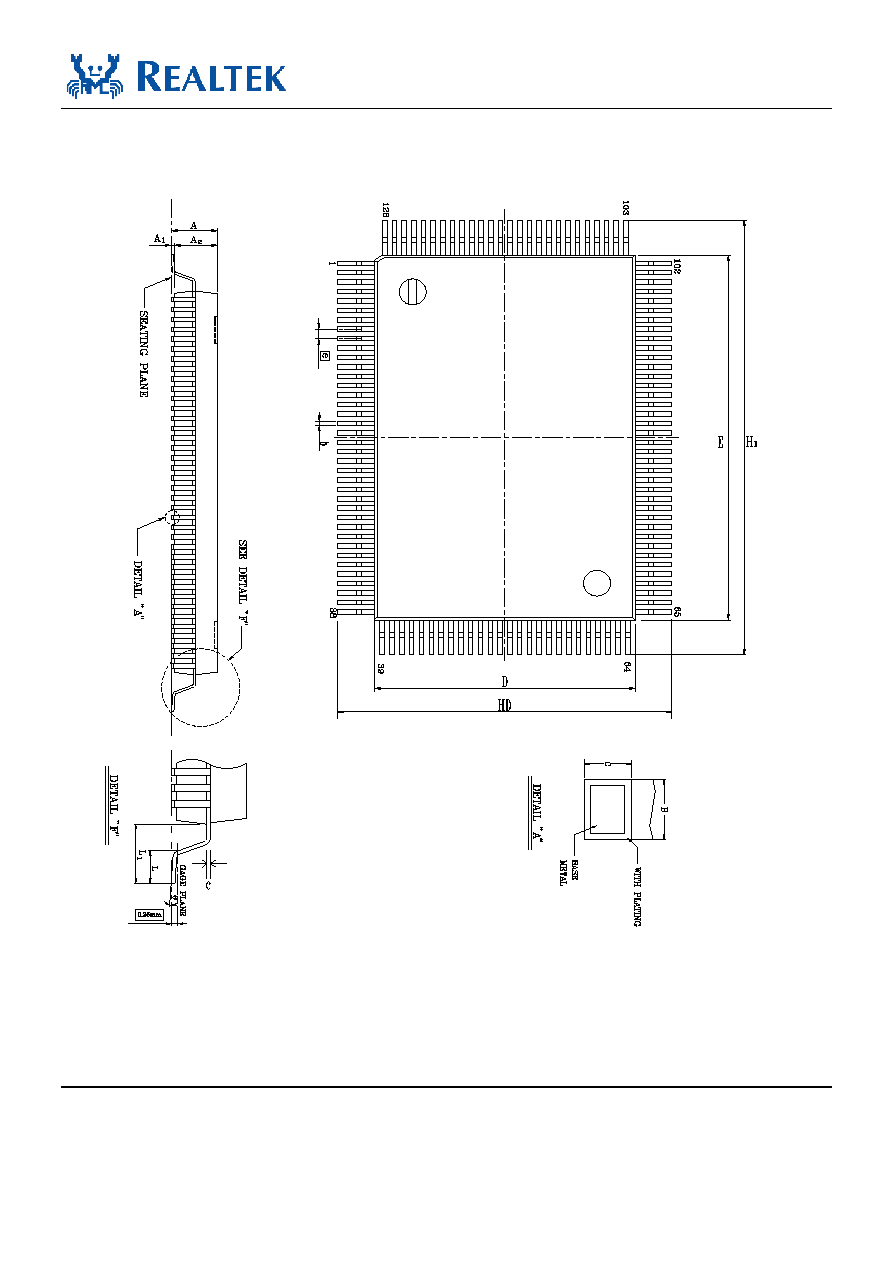
RTL8169SB(L)
Datasheet
Integrated Gigabit Ethernet Controller (NIC) 41
Track ID: JATR-1076-21 Rev. 1.5
8.3. 128-Pin LQFP Mechanical Dimensions
See the Mechanical Dimensions notes on the next page.
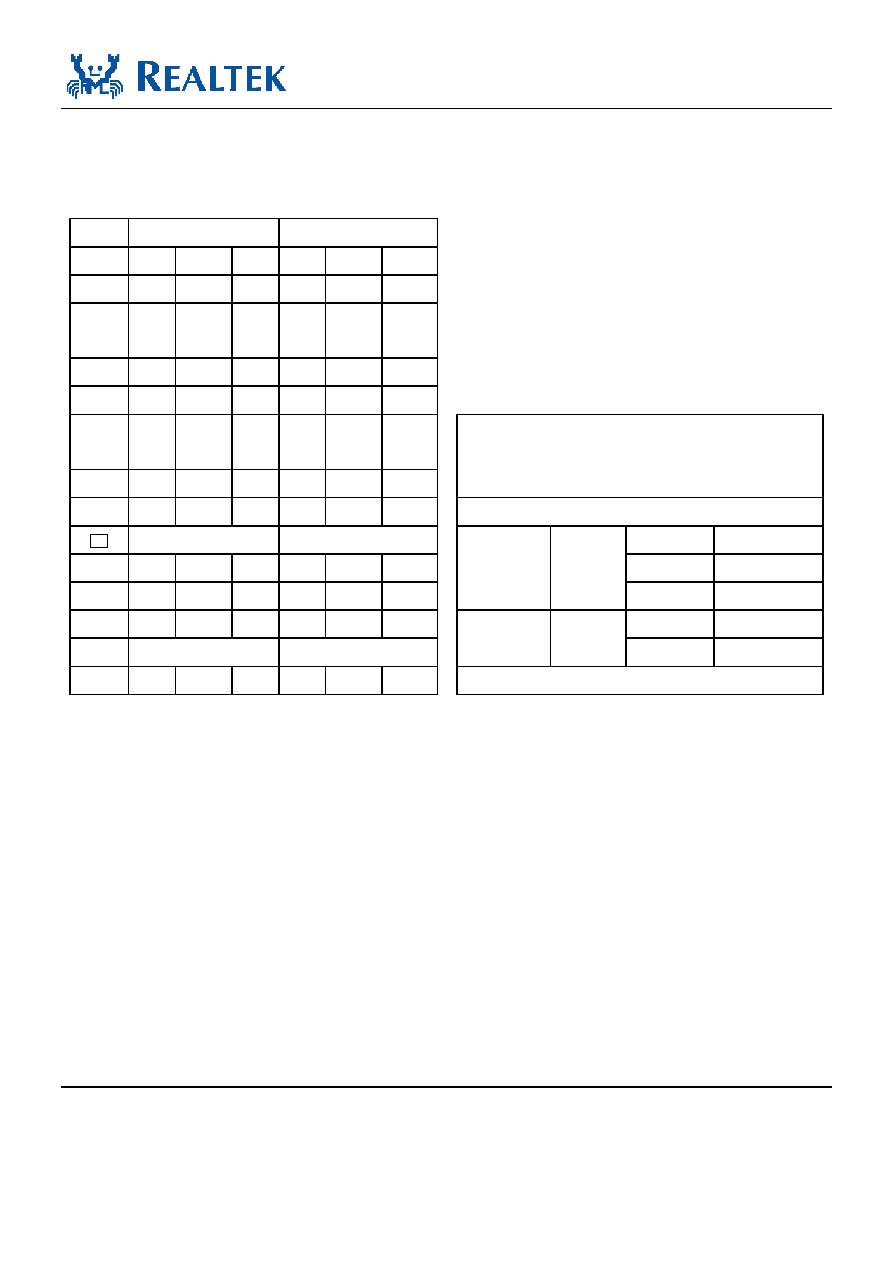
RTL8169SB(L)
Datasheet
Integrated Gigabit Ethernet Controller (NIC) 42
Track ID: JATR-1076-21 Rev. 1.5
8.4. Notes for 128-Pin LQFP Dimensions
Symbol
Dimension in inch
Dimension in mm
Notes:
Min
Type
Max
Min
Type
Max 1.Dimension b does not include dambar protrusion/intrusion.
A
- -
0.067
- - 1.70
2.Controlling
dimension:
Millimeter
A1
0.000 0.004 0.008
0.00
-
0.25 3. General appearance spec. Should be based on final
visual inspection.
A2
0.051 0.055 0.059
1.30 1.40
1.50
b
0.006 0.009 0.011
0.15 0.22
0.29
c
0.004 - 0.006
0.09
-
0.20 TITLE: 128LD LQFP ( 14x20x1.4 mm*2 ) PACKAGE
OUTLINE
D
0.541 0.551 0.561 13.75 14.00
14.25
CU L/F, FOOTPRINT 2.0 mm
E
0.778 0.787 0.797 19.75 20.00
20.25
LEADFRAME
MATERIAL:
e
0.020
BSC 0.50 BSC
APPROVE
DOC.
NO.
HD
0.620 0.630 0.640 15.90 16.00
16.30
VERSION
HE
0.855 0.866 0.877 21.70 22.00
23.30
PAGE
L
0.016 0.024 0.031
0.45 0.60
0.75
CHECK
DWG NO.
LQ128 - 1
L1
0.039
REF 1.00 REF
DATE
0
∞ 3.5∞
9
∞
0
∞ 3.5∞
9
∞
REALTEK SEMICONDUCTOR CORP.

RTL8169SB(L)
Datasheet
Integrated Gigabit Ethernet Controller (NIC) 43
Track ID: JATR-1076-21 Rev. 1.5
9. Ordering
Information
Table 20. Ordering Information
Part number
Package
Status
RTL8169SB 128-pin
QFP
RTL8169SBL 128-pin
LQFP
RTL8169SB-LF 128-pin
QFP
RTL8169SBL-LF 128-pin
LQFP
Realtek Semiconductor Corp.
Headquarters
No. 2, Industry East Road IX, Science-based
Industrial Park, Hsinchu, 300, Taiwan, R.O.C.
Tel: 886-3-5780211 Fax: 886-3-5776047
www.realtek.com.tw
















































